
|

|
U.S. Civil War Artillery, Cannon, Howitzers, and Mortars
A Photographic History of Light and Heavy Artillery
American Civil War Artillery and Cannon
Field, Siege and Garrison, and Seacoast (Coastal) Guns
Foreword

On the American Civil War battlefield (1861-1865), Napoleon's artillery
tactics were no longer practical. The infantry, armed with its own comparatively long-range firearm, was usually able to keep
artillery beyond case-shot range, and cannon had to stand off at such long distances that their primitive ammunition was relatively
ineffective. The result was that when attacking infantry advanced, the defending infantry and artillery were still fresh and
unshaken, ready to pour a devastating point-blank fire into the assaulting lines. Thus, in spite of an intensive 2-hour bombardment
by 138 Confederate guns at the crisis of Gettysburg, as the gray-clad troops advanced across the field to close range, double
canister and concentrated infantry volleys cut them down in masses.
Field artillery smoothbores, under conditions prevailing during the war,
generally gave better results than the smaller-caliber artillery rifle. A 3-inch rifle, for example, had twice the range
of a Napoleon; but in the broken, heavily wooded country where so much of the fighting occurred, the superior range of the
rifle could not be employed to full advantage. Neither was its relatively small and sometimes defective projectile as damaging
to personnel as case or grape from a larger caliber smoothbore. At the first battle of Manassas (July 1861) more than half
the 49 Federal cannon were rifled; but by 1863, even though many more rifles were in service, the majority of the pieces in
the field remained the old reliable 6- and 12-pounder smoothbores.
The range and accuracy of the rifles startled the world. A 30-pounder
(4.2-inch) Parrott had an astonishing distance of 8,453 yards (7729 meters), just shy of 5 miles (8 kilometers), with
80-pound hollow shot; the notorious "Swamp Angel" that fired on Charleston in 1863 was a 200-pounder Parrott mounted in the
marsh 7,000 yards from the city. But perplexing to both armies, neither rifles nor smoothbores could destroy earthworks.
As was proven several times during the war, the defenders of a well-built earthwork were able to repair the trifling damage
done by enemy fire almost as soon as there was a lull in the shooting. Learning this lesson, the determined Confederate
defenders of Fort Sumter in 1863-64 refused to surrender, but under the most difficult conditions converted their ruined masonry
into an earthwork almost impervious to further bombardment.
The following American Civil War work is a fascinating yet captivating read,
an encyclopedic photographic presentation and history of the conflict and its impressive artillery and cannon. This study
also shows that the artillerist was a well-trained and highly intelligent soldier, regardless of the color
of the uniform.
Introduction
| Masonry fort damaged by rifled artillery |
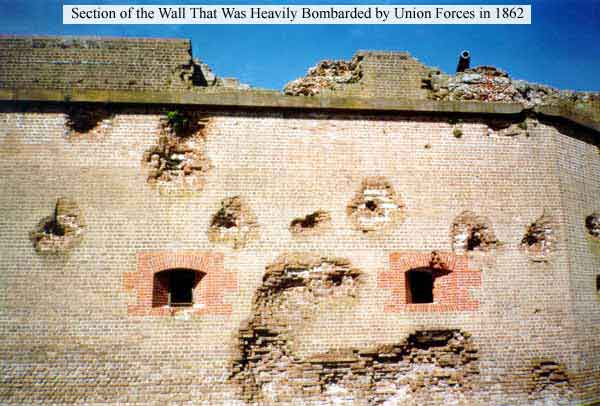
|
| Fort Pulaski as a result of Union rifled artillery fire |
Artillery during the U.S. Civil War (1861-1865) had many makes, models,
classifications, types, and characteristics, but each piece, whether referred to as a smoothbore garrison gun, rifled field
piece, or seacoast howitzer, was an integral part of both the Union and Confederate army organization known as the artillery
branch. The artillery branch was one of three principal branches that formed the army; the other two were the infantry and
cavalry. As the physical body has parts, and parts have functions, so did the Civil War army.
The infantry was the legs that carried the body into the brunt of the fighting, while the cavalry was the eyes that could
locate and direct the body prior, during and even after the battle (cavalry also fought, but mainly dismounted), and the artillery
was the arms that was capable of reaching out and touching the enemy from a distance. The body requires the legs, the arms,
and the eyes in order to function perfectly. Remove an eye, the body suffers. Remove a leg, the body suffers. Remove an arm
and a leg and the body suffers severely. So one member or part of the body is not more vital and significant
than another part, but together, each part forms the unit, the Civil War army unit. A well-disciplined and trained body, army
body, consisting of artillery, infantry, and cavalry functioning jointly, with each member performing its respective
responsibilities and roles, was the goal of both Northern and Southern armies. Most battles during the Civil War were lost
because the body was absent or missing a "part" prior or during the engagement. On the other hand, one army was victorious
during the battle because its body remained intact and functioned well.
(Right) Photograph of Union projectile damage to Fort Pulaski's walls. At 8:15 am on April 10, 1862, Union batteries opened fire on the eleven feet thick
walls of Fort Pulaski. Believed by most to be an impenetrable fortress, the smoothbore guns merely shook Pulaski's
walls “in a random manner,” but a battery of 30-pounder
Parrott Rifles thundered their projectiles with exceptional accuracy into the fort's walls and within 30 hours
the new rifled cannons had breached one of the fort's corner walls and shells now passed through the fort dangerously
close to the main powder magazine. With the loss of one soldier and absent the classic siege, the Confederate force
was compelled to surrender. The success of the siege was the use
of new rifled cannons by the Union artillery. These new weapons were able to fire their elongated projectiles farther and
more accurately than the smoothbore cannons that Fort Pulaski was built to withstand. The cannonading had transformed the newly
constructed masonry forts of the Third System of United States Coastal Defense from impenetrable bastions of ingenious
engineering to obsolete symbols of American paranoia and excess.
The American Civil War has been referred to as the last of the ancient wars and the first of
the modern wars. When the Civil War commenced, weaponry of all types was in short supply. Many soldiers were issued antiquated,
imported, and nearly obsolete weapons. However, by the time of the Battle of Gettysburg, a few quality types were obtained
in large numbers and became standard issue to the soldiers of both armies.
Although more innovative and experimental weaponry was introduced during the Civil War than all previous wars
combined, the military units relied on traditional Napoleonic-style tactics. Infantry fought in closely-knit formations of
two rows, each man standing side by side. This formation was devised when the smoothbore musket was the normal weapon on the
battlefield and the close ranks were a necessity due to the muskets limitations. With the advance of the rifle musket, which
included grooves in the barrel allowing much greater range and accuracy, officers, many who had been taught Napoleonic tactics
at West Point, continued to employ the outdated tactics during the conflict. An exception to the employment of the obsolete
tactics arrived late in the Civil War with trench warfare in the Eastern Theater. During the nearly ten month Richmond-Petersburg
Siege, trenches replaced the constant close range attack and counterassault, retreat and counterattack
tactics. Unfortunately, failure to adopt modern tactics with modern weapons, with few exceptions, resulted in unimaginable casualty
rates on the battlefield. While cannoneers were accustomed to being deployed at short distances and in close support
of infantry, the opposing infantrymen with rifled muskets could now decimate an entire artillery battery in minutes.
To assist in this artillery study, a glossary is located at the bottom of the page.
| Columbiad guns during the Civil War |
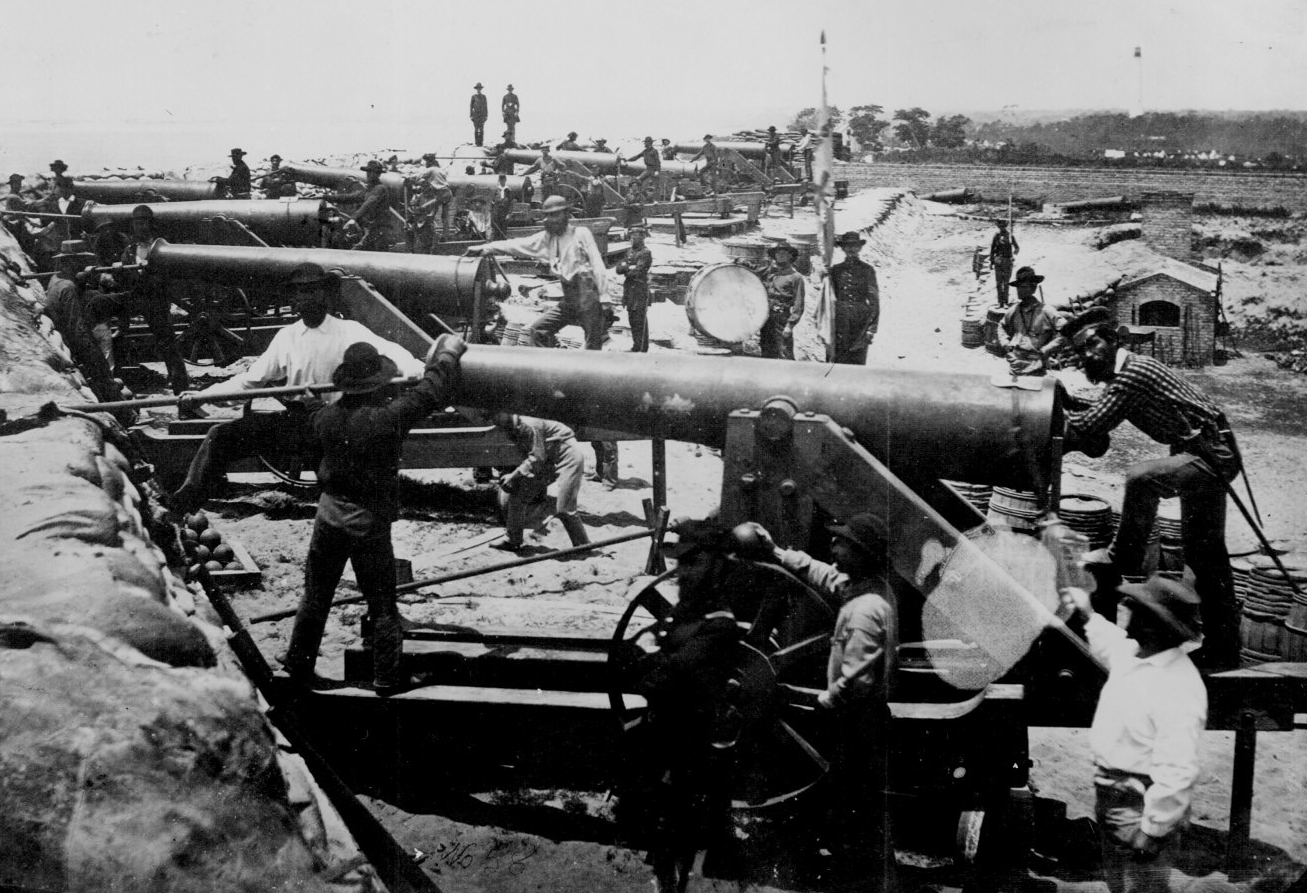
|
| Columbiad guns of the Confederate water battery at Warrington, FL. (Pensacola Bay), Feb. 1861 |
(Above) Formidable Columbiad guns of the Confederate water battery at Warrington,
Florida. Warrington was considered the "mouth and entrance to Pensacola Bay." February 1861. Photographed by W. O. Edwards
or J. D. Edwards of New Orleans, LA. Library of Congress. 77-HL-99-1.
Union Artillery
The Union Army entered the war with a strong advantage
in artillery. It had ample manufacturing capacity in Northern factories, and it had a well-trained and professional officer
corps manning that branch of the service. Brig. Gen. Henry J. Hunt, who was the chief of artillery for the Army of the Potomac
for part of the war, was well recognized as a most efficient organizer of artillery forces, and he had few peers in the practice
of the sciences of gunnery and logistics. Another example was John Gibbon, the author of the influential Artillerist's Manual
published in 1863 (although Gibbon would achieve considerably more fame as an infantry general during the war). Shortly after
the outbreak of war, Brig. Gen. James Wolfe Ripley, Chief of Ordnance, ordered the conversion of old smoothbores into rifled
cannon and the manufacture of Parrott guns.
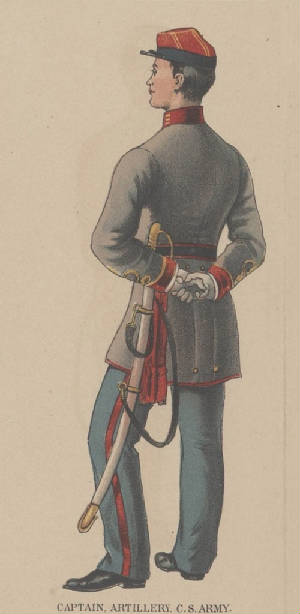
Parrott
"Class" Guns by Size
| Model |
Length |
Weight |
Munition |
Charge size |
Maximum range at elevation |
Flight time |
Crew size |
| 2.9-in (10-lb) Army Parrott |
73 in |
1,799 lb (816 kg) |
10 lb (4.5 kg) shell |
1 lb (0.45 kg) |
5,000 yd (4,600 m) at 20 degrees |
21 secs |
6 |
| 3.0-in (10-lb) Army Parrott |
74 in |
1,726 lb (783 kg) |
10 lb (4.5 kg) shell |
1 lb (0.45 kg) |
1,830 yd (1,670 m) at 5 degrees |
7 secs |
6 |
| 3.67-in (20-lb) Army Parrott |
79 in |
1,795 lb (814 kg) |
19 lb (8.6 kg) shell |
2 lb (0.91 kg) |
4,400 yd (4,000 m) at 15 degrees |
17 secs |
7 |
| 3.67-in (20-lb) Naval Parrott |
81 in |
1,795 lb (814 kg) |
19 lb (8.6 kg) shell |
2 lb (0.91 kg) |
4,400 yd (4,000 m) at 15 degrees |
17 secs |
7 |
| 4.2-in (30-lb) Army Parrott |
126 in |
4,200 lb (1,900 kg) |
29 lb (13 kg) shell |
3.25 lb (1.47 kg) |
6,700 yd (6,100 m) at 25 degrees |
27 secs |
9 |
| 4.2-in (30-lb) Naval Parrott |
102 in |
3,550 lb (1,610 kg) |
29 lb (13 kg) shell |
3.25 lb (1.47 kg) |
6,700 yd (6,100 m) at 25 degrees |
27 secs |
9 |
| 5.3-in (60-lb) Naval Parrott |
111 in |
5,430 lb (2,460 kg) |
50 lb (23 kg) or 60 lb (27 kg) shell |
6 lb (2.7 kg) |
7,400 yd (6,800 m) at 30 degrees |
30 secs |
14 |
| 5.3-in (60-lb) Naval Parrott (breechload) |
111 in |
5,242 lb (2,378 kg) |
50-lb or 60 lb (27 kg) shell |
6 lb (2.7 kg) |
7,400 yd (6,800 m) at 30 degrees |
30 secs |
14 |
| 6.4-in (100-lb) Naval Parrott |
138 in |
9,727 lb (4,412 kg) |
80 lb (36 kg) or 100 lb (45 kg) shell |
10 lb (4.5 kg) |
7,810 yd (7,140 m) at 30 degrees (80-lb) |
32 secs |
17 |
| 6.4-in (100-lb) Naval Parrott (breechload) |
138 in |
10,266 lb (4,657 kg) |
80 lb (36 kg) or 100 lb (45 kg) shell |
10 lb (4.5 kg) |
7,810 yd (7,140 m) at 30 degrees (80-lb) |
32 secs |
17 |
| 8-in (150-lb) Naval Parrott |
146 in |
16,500 lb (7,500 kg) |
150 lb (68 kg) shell |
16 lb (7.3 kg) |
8,000 yd (7,300 m) at 35 degrees |
180 |
? |
| 8-in (200-lb) Army Parrott |
146 in |
16,500 lb (7,500 kg) |
200 lb (91 kg) shell |
16 lb (7.3 kg) |
8,000 yd (7,300 m) at 35 degrees |
? |
? |
| 10-in (300-lb) Army Parrott |
156 in |
26,900 lb (12,200 kg) |
300 lb (140 kg) shell |
26 lb (12 kg) |
9,000 yd (8,200 m) at 30 degrees |
202.5 secs |
? |
(Above) While the 4.2-in (30-pounder) rifle was the most widely used
of the Parrott siege artillery, it had the honor of occasionally being employed as field artillery. The 30-pounder Parrott had
a total weight (Gun & Carriage) of 6,500 lbs. (3.25 tons) and it required 10 horses for transport.
The basic unit of Union artillery was the battery, which usually consisted of six guns. Attempts
were made to ensure that all six guns in a battery were of the same caliber, simplifying training and logistics. Each gun,
or "piece", was operated by a gun crew of eight, plus four additional men to handle the horses and equipment. Two guns operating under the control of a lieutenant were known as a "section". The battery of six guns was
commanded by a captain. Artillery brigades composed of five batteries were commanded by colonels and supported the infantry
organizations as follows: each infantry corps was supported directly by one artillery brigade and, in the case of the Army
of the Potomac, five brigades formed the Artillery Reserve. This arrangement, championed by Hunt, allowed artillery to be
massed in support of the entire army's objective, rather than being dispersed all across the battlefield. An example of the
tension between infantry commanders and artillery commanders was during the massive Confederate bombardment of Cemetery Ridge
on 3 July 1863, the third day of the Battle of Gettysburg. Hunt had difficulty persuading the infantry commanders, such as
Maj. Gen. Winfield S. Hancock, against using all of their artillery ammunition in response to the Confederate bombardment,
understanding the value to the defenders of saving the ammunition for the infantry assault to come, Pickett's Charge.
| Civil War artillery and cannon history |
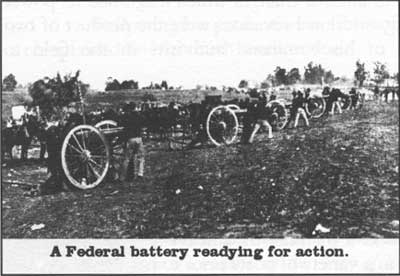
|
| Civil War artillery battery |
At the start of the war, the U.S. Army had 2,283 guns in its arsenal, but
approximately 10% of these were field artillery pieces. By the end of the war, the army had amassed 3,325 guns,
of which 53% were field pieces. The army reported as "supplied to the army during the war" the following quantities: 7,892
guns, 6,335,295 artillery projectiles, 2,862,177 rounds of fixed artillery ammunition, 45,258 tons of lead metal, and 13,320
tons of gunpowder.
(Right) Union field artillery battery supporting infantry during Battle
of Fredericksburg. Practice, practice, practice, and more practice, were the words of many weary cannoneers prior to
firing a single shot in combat. But when the artillerists' indomitable efforts were finally demonstrated on
the battlefield, the results were evident to opposing sides. And it was practice that had meant the difference between life
and death. Napoleonic tactics made Civil War artillery
crucial to the outcome of many Civil War battles. Mass formations of soldiers, with great discipline, would march across open
fields and directly into enemy shot and shell from artillery pieces as viewed in the photo.
Confederate Artillery
The South was at a relative disadvantage to the North for deployment of
artillery. The industrial North had far greater capacity for manufacturing weapons, and the Union blockade of Southern ports
prevented many foreign arms from reaching the Southern armies. The Confederacy had to rely to a significant extent on captured
Union artillery pieces: either on the battlefield or by capturing armories, such as Harpers Ferry. The Confederate cannons
built in the South often suffered from the shortage of quality metals and shoddy workmanship. Another disadvantage was the
quality of ammunition. The fuzes needed for detonating shells and cases were frequently inaccurate, causing premature or delayed
explosions. All that, coupled with the Union gunners' initial competence and experience gained as the war progressed, led
Southern forces to dread assaults on Northern positions backed up by artillery. A Southern officer observed, "The combination
of Yankee artillery with Rebel infantry would make an army that could be beaten by no one."
Confederate batteries usually consisted of four guns, in contrast to the
Union's six. This was a matter of necessity, because guns were always in short supply. And, unlike the Union, batteries frequently
consisted of mixed caliber weapons. Confederate batteries were generally organized into battalions (versus the Union brigades)
of four batteries each, and the battalions were assigned to the direct support of infantry divisions. Each infantry corps
was assigned two battalions as an Artillery Reserve, but there was no such Reserve at the army level. The chief of artillery
for Robert E. Lee's Army of Northern Virginia, Brig. Gen. William N. Pendleton, had considerable difficulty massing artillery
for best effect because of this organization.
| Artillery was one of three Army components |
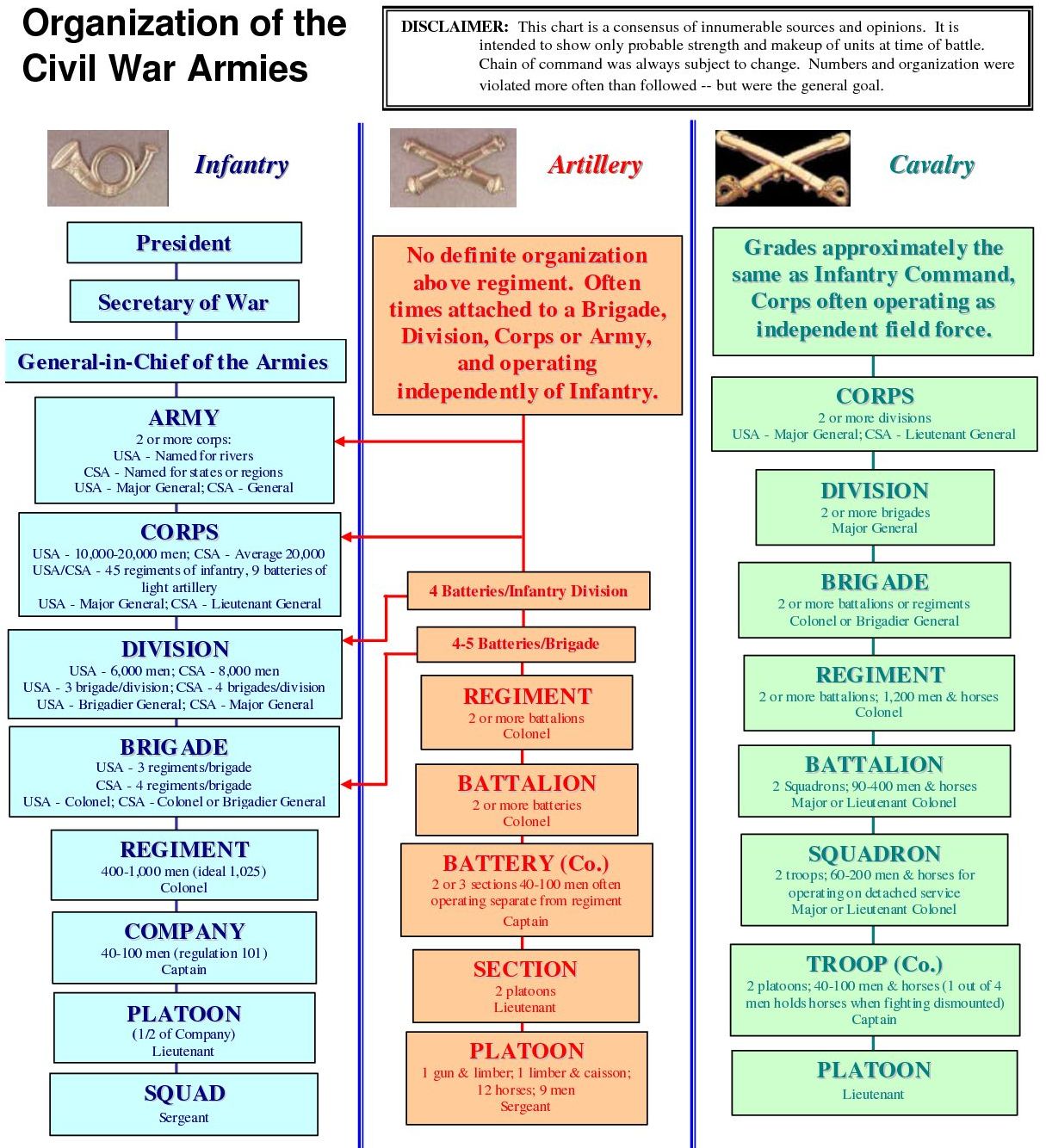
|
| The Civil War Army organization consisted primarily of infantry, .artillery, and cavalry |
| Civil War artillery battery formation |
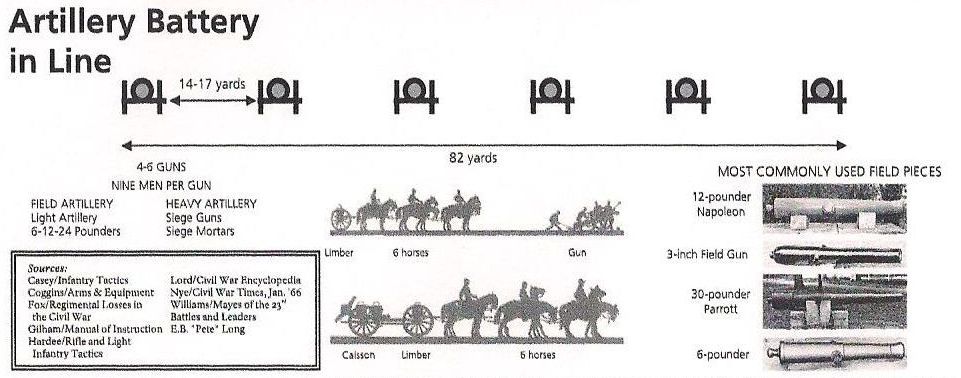
|
| Civil War artillery battery in line, with acknowledgment of most widely used field pieces |
| Artillery trajectories |

|
| Civil War mortars, howitzers, and guns |
During the Civil War, the Artillery was a separate, specialized branch of
the army that supported the Infantry. The basic organizational unit for cannons was called a battery, comprised of four to
six guns with approximately 70-100 men commanded by a Captain. There were three types of artillery employed during the conflict:
field, siege and garrison, and seacoast. Although there were many models and sizes of guns, mortars, and howitzers, there
were two basic types--smoothbore and rifled.
Guns, when referring to artillery and cannon, were employed to batter heavy
construction with solid shot at long or short range; destroy fort parapets and, by ricochet fire, dismount cannon; shoot grape,
canister, or other projectiles against massed personnel. Mortars were used to destroy targets behind obstructions; use
high angle fire to shoot projectiles, destroying construction and killing personnel. During siege operations, mortars were
successful in lobbing explosive shells into trenches, and, with precision, could hit targets accustomed to the safety
of defilade. Howitzers, however, could be transported more easily in the field than mortars; destroy targets behind
obstructions by high angle fire; shoot larger projectiles than could field guns of similar weight.
The Union Army classified its artillery into three specific types,
depending on the gun's weight and intended use. Field artillery were light pieces that often traveled with the armies. Siege
artillery and garrison artillery were heavy artillery primarily used in military attacks on fortified places. Seacoast artillery were
the heaviest pieces and primarily designed to fire on attacking warships. The distinctions were subjective, because,
according to exigencies of war, field, siege and garrison, and seacoast artillery were all employed in various attacks
and defenses of fortifications. Although there were three specific types of artillery, the Union and Confederate military,
because of the gun's weight, usually grouped its artillery into two categories: light and heavy.
| Civil War artillery and cannon |

|
| Guns, Mortars, and Howitzers |
Field artillery was a category of light, mobile artillery used to support
armies in the field. Field pieces were specialized for mobility, tactical proficiency, long range, short range and
extremely long range target engagement. Field artillery in the American Civil War refers to the important artillery weapons,
equipment, and practices used by the Artillery branch to support the infantry and cavalry forces in the field. Field artillery
was also known as foot artillery, for while the guns were pulled by beasts of burden (often horses), the gun crews would usually
march on foot, thus providing fire support mainly to the infantry. This was in contrast to horse artillery, aka flying artillery,
whose emphasis on speed while supporting cavalry units necessitated lighter guns and crews riding on horseback. Horse artillery
was a type of light, fast-moving and fast-firing artillery which provided highly mobile fire support to Civil War armies --
especially to cavalry units. It consisted of light cannons or howitzers attached to light but sturdy two-wheeled carriages
called caissons or limbers, with the crew riding horses or sometimes the caissons into battle. This was unlike field
artillery where the pieces were heavier and the crew marched on foot. "Stonewall" Jackson was cognizant of the advantages
of flying artillery, and he advocated that one should "strike the enemy first, then relocate your force rapidly, then strike
the enemy again, and continue the process until the enemy has been defeated..." Jackson had excelled in the application
of flying artillery during the Mexican-American War (1846-1848), earning himself a promotion to brevet major, and he
would apply his textbook maneuvers during the Civil War. Preceding the Southern rebellion in 1861, Jackson taught artillery,
among other subjects, at Virginia Military Institute.
Siege and garrison artillery were heavy pieces that could be used either
in attacking or defending fortified places, but the weight and size of siege artillery prevented it from regularly traveling
with the armies. When needed, siege artillery and other material needed for siege operations were assembled into what was
called a siege train and transported to the army. In the Civil War, the siege train was always transported to the area of
the siege by water. The siege trains of the Civil War consisted almost exclusively of guns and mortars. Guns fired projectiles
on horizontal trajectory and could batter heavy construction with solid shot or shell at long or short range, destroy fort
parapets, and dismount cannon. Mortars fired shells in a high arcing trajectory to reach targets behind obstructions, destroying
construction and personnel.
Seacoast artillery, aka Coastal artillery, were the heaviest pieces
and were intended to be used in permanent fortifications along the seaboard. They were primarily designed to fire on attacking
warships. Seacoast artillery was employed according to exigencies of battle, however. For example, a Federal battery
with Model 1861 13-inch seacoast mortars was utilized during the Siege of Yorktown, Virginia, in 1862.
| Civil War Seacoast mortar on Morris Island, S.C. |
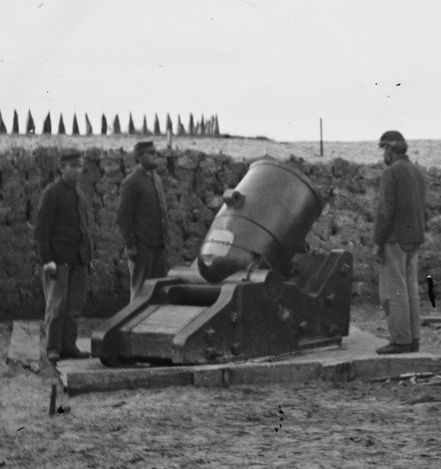
|
| Union Model 1841 10 in. Seacoast mortar during Siege of Charleston |
| Civil War Siege mortar |
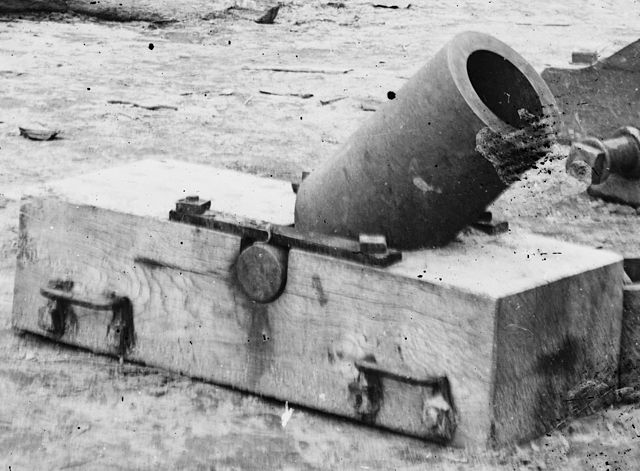
|
| Confederate iron 24-pounder Coehorn mortar at Broadway Landing, Appomattox River, Virginia |
| Horse Artillery, aka Field Artillery |
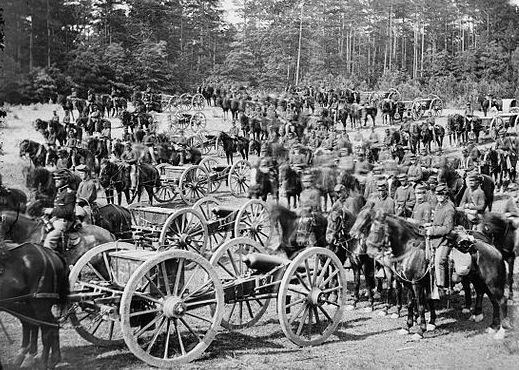
|
| Horse Artillery. Battery M, 2nd U.S. Artillery in the field, 1862 |
Horses were required to pull the enormous weight of the cannon and ammunition;
on average, each horse pulled approximately 700 pounds (317.5 kg). Each gun in a battery used two six-horse teams: one team
pulled a limber that towed the gun, the other pulled a limber that towed a caisson. The large number of horses posed a logistical
challenge for the artillery, because they had to be fed, maintained, and replaced when worn out or injured. Artillery horses
were generally selected second from the pool of high quality animals; cavalry mounts were the best horses. The life expectancy
of an artillery horse was under eight months. They suffered from disease, exhaustion from long marches—typically 16
miles (25.8 km) in 10 hours—and battle injuries.
Because horses were large targets on the battlefield, when subjected
to counter-battery fire, their movements were made difficult because they were harnessed into teams. Robert Stiles wrote about
Union fire striking a Confederate battery on Benner's Hill at the Battle of Gettysburg:
"Such a scene as it presented—guns dismounted and disabled, carriages
splintered and crushed, ammunition chests exploded, limbers upset, wounded horses plunging and kicking, dashing out the brains
of men tangled in the harness; while cannoneers with pistols were crawling around through the wreck shooting the struggling
horses to save the lives of wounded men."
Acquiring horses proved challenging for the Union Army by 1864,
because it required 500 additional horses each day in order to sustain its presence in the field. Sheridan's army
alone, while contesting Early in the Shenandoah Valley in '64, consumed 150 steeds daily. The Confederate
military, on the other hand, could not replace man nor horse (nor munitions) in said year. The weight of attrition would
literally cause the fledgling nation to buckle and then collapse. See also Civil War Horses.
The term "horse artillery" refers
to the faster moving artillery batteries that typically supported cavalry regiments. The term "flying artillery" was
sometimes used as well. In such batteries, the artillerymen were all mounted, in contrast to batteries in which the artillerymen
walked alongside their guns. A prominent organization of such artillery in the Union Army was the U.S. Horse Artillery Brigade.
Horse artillery, or flying artillery, was an organization equipped usually
with 10-pounder rifled guns, with all hands mounted. In ordinary light artillery the cannoneers either rode on the gun-carriage
or walked. In flying artillery each cannoneer has a horse. This form was by far the most mobile of all, and was best suited
to accompany cavalry on account of its ability to travel rapidly. With the exception of the method of mounting the cannoneers,
there was not any difference between the classes of field batteries except as they were divided between “light”
and “heavy.”
Limber
The limber was a two-wheeled carriage that carried an ammunition
chest. It was connected directly behind the team of six horses and towed either a gun or a caisson. In either case, the combination
provided the equivalent of a four-wheeled vehicle, which distributed the load over two axles but was easier to maneuver on
rough terrain than a four-wheeled wagon. The combination of a Napoleon gun and a packed limber weighed 3,865 pounds (1,753.1
kg).
Caisson
The caisson was also a two-wheeled carriage. It carried two ammunition
chests and a spare wheel. A fully loaded limber and caisson combination weighed 3,811 pounds (1728.6 kg). The limbers, caissons,
and gun carriages were all constructed of oak. Each ammunition chest typically carried approximately 500 pounds (226.8 kg)
of ammunition or supplies. In addition to these vehicles, there were also battery supply wagons and portable forges that were
used to service the guns.
Cannon Crew
Eight
cannoneers were needed to fire field pieces. Five were at the gun--the gunner and cannoneers 1, 2, 3, 4. The gunner was in
charge of the piece, he gave the commands and conducted the aiming. Cannoneers 1-4 actually loaded, cleaned and fired
the gun. Cannoneer 5 carried the ammunition from the limber to the gun. Cannoneers 6 and 7 prepared ammunition and cut
the fuzes.
| Civil War cannon positions |
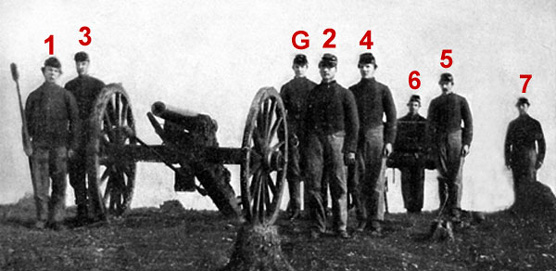
|
| Civil War cannoneers and their respective positions |
| How to load a cannon and fire a cannon |
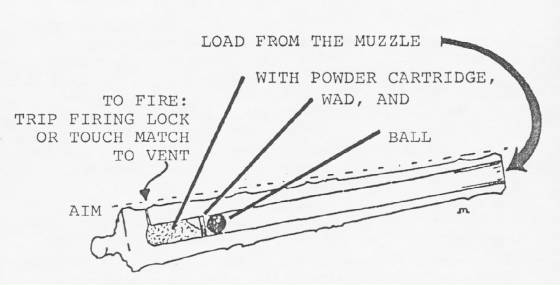
|
| Loading and aiming a muzzle-loading smoothbore gun |
| Civil War artillery and cannon positions |

|
| Civil War artillery crew positions |
Weapons
Although the Union and Confederate artillery inventories consisted primarily
of muzzle-loaders, the two general types of muzzle-loading artillery weapons used during the Civil War were smoothbores and
rifles. Smoothbores included howitzers and guns. A smoothbore cannon barrel is just like a pipe, smooth on the inside. In
contrast, a rifled cannon has grooves cut into the inside of the barrel, which forced the ammunition to rotate like a football.
A rifled cannon was more accurate and had a greater range than a smoothbore gun. An example would be to throw a volleyball
and then a football at a target from a distance of 100 yards. While you would need a strong arm to achieve this task,
the volleyball would drift and deviate over the distance, while the rotating football would exhibit an effortless
flight with stunning accuracy.
Smoothbore versus Rifled
The two primary rifled guns employed by both sides were the 3-inch Ordnance
Rifle and the Parrott Rifle. The rifled cannon had three distinct advantages over the smoothbore. The first was the range
that these weapons could attain. The smoothbore Napoleon could negotiate 1,619 yards at a 5 degree elevation, while the
10-pounder Parrott and the 3-Inch Ordnance Rifle could achieve 2,000 yards and 1,835 yards respectively.
The second advantage was the rifling, which allowed the elongated projectile
to spiral and thus maintain a more accurate course to the target. The smoothbore Napoleons had spherical ammunition that navigated
a smooth barrel, exiting with far less accuracy. Thus, at greater ranges it was quite difficult to hit a target.
One celebrated exception was when the Confederate artilleryman "Pelham hit a Union standard-bearer at 800 yards with one shot".
While this might not appear challenging, the deviation of the ball in flight was 3 feet at 600 yards and 12 feet at 1,200
yards.
| British made Whitworth Breech-loader |
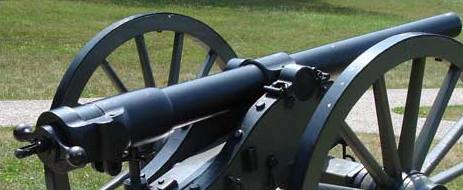
|
| 12 pdr. Whitworth Breechloading Rifle |
The third advantage to the rifled guns was that, shot for shot, they
used less gunpowder than the smoothbores. The reason for this was the windage of the smoothbores. This occurred because
a portion of the force from the exploding gunpowder would pass around the ball and not propel it. In the rifled guns, the
conical shot was more tightly fitted to the bore which considerably reduced the windage. When this was combined with the shape
itself of the conical shot, which retained velocity better than the round shot fired from the smoothbore, less powder was
required to propel the shot. This allowed a reduction in the weight of the gun as the amount of force on the breech was considerably
lessened. As a more direct comparison in gun weight, the 14-Pounder James Rifle fired a slightly heavier shot than the Napoleon,
but the gun weighed 300 pounds less and used 1.75 pounds less gunpowder.
Advantage of smoothbore field artillery, however, under conditions
prevailing during the Civil War, generally gave better results than the smaller-caliber rifle. A 3-inch rifle, for instance,
had twice the range of a Napoleon; but in the broken, heavily wooded country where much of the fighting took place, the superior
range of the rifle could not be used to full advantage. Neither was its relatively small and sometimes defective projectile
as damaging to personnel as case or grape from a larger caliber smoothbore.
Although rifled artillery eventually phased out the smoothbore, during the war both types
were appreciated as each employed its advantages on the battlefield.
Muzzle-loader vs. Breech-loader
Although muzzle-loading smoothbore cannon were used for almost 700 years,
the art of loading and aiming a muzzle-loading smoothbore and next generation rifled gun was simple in principle but
required exhaustive hours of training to acquire the necessary skill. While few breech-loading cannons were used during
the Civil War, they, however, proved problematic. But manufacturing and employment of breech-loaders during the
four year conflict was proceeded with decades of continued research and development of the weapon, thus resulting
in breech-loaders that quickly excelled and outclassed its counterpart, the muzzle-loader, in every characteristic.
While muzzle-loading was time consuming, breech-loading removed the
cumbersome muzzle-loader and it afforded: less exposure to men; reduced size of embrasures, securing greater rapidity
of fire; increased length of bore, and hence greater power; and also affording greater facilities for bore examinations, and
permitting an ease in loading not afforded in long-bored muzzle-loading guns; and the latter exhibiting the dangers arising
from the possibilities of double charging, and the cumbersomeness and complications of loading devices necessary for the use
of muzzle-loading guns, more especially in the naval service, where economy of space is a matter of vital importance. From
ship to shore, from nation to nation, the superiority of breech-loading guns is evident in the inventories of every army
and navy.
| Comparison of smoothbore and rifled cannon pieces |
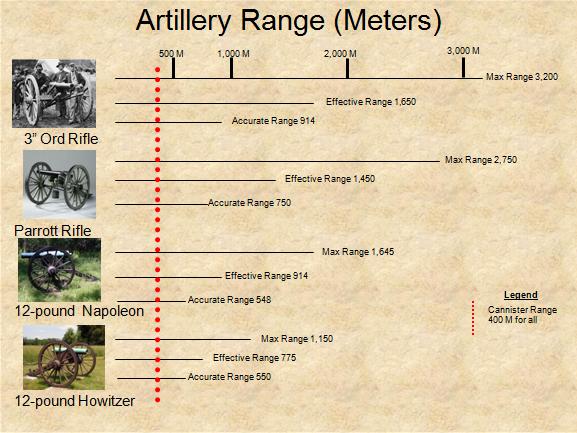
|
| Comparison of the most widely employed Smoothbore cannon and rifled artillery pieces |
| Smoothbore and Rifled Cannon Types |
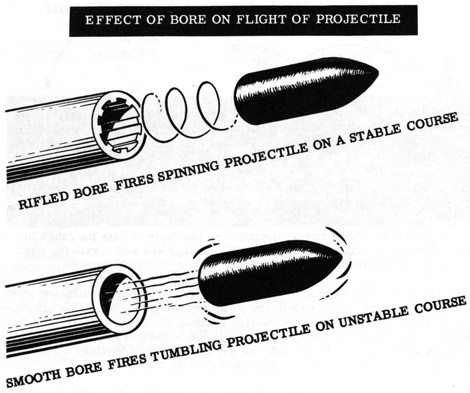
|
| Difference between smoothbore and rifled barrels |
(Above) Rifled artillery proved quickly that masonry fortifications were
obsolete. Smoothbore guns, however, demonstrated its continued lethality as an anti-personnel weapon.
Smoothbore Artillery
A smoothbore weapon is one which has a smooth barrel, and is absent rifling.
Smoothbores ranged from small arms to heavy siege and garrison guns. Early firearms had smooth barrels, and fired projectiles
with no significant spin. These projectiles had to have stable shapes, such as finned arrows or spheres, to minimize tumbling
during flight. However, spherical bullets do tend to rotate randomly during flight, and the Magnus effect means that even
a relatively smooth sphere will curve when rotating on any axis not parallel to the direction of travel.
Smoothbore artillery refers to weapons that were not rifled. At the time of the Civil War, metallurgy
and other supporting technologies had just recently evolved to a point allowing the large scale production of rifled field
artillery. As such, many smoothbore weapons were still in use and production even at the end of the war. Smoothbore field
artillery of the day fit into two role-based categories: guns and howitzers. Further classifications of the weapons were made
based on the type of metal used, typically bronze or iron (cast or wrought), although some examples of steel were produced.
Additionally, the artillery was often identified by the year of design in the Ordnance department references.
| Smoothbore barrel |
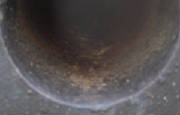
|
| Inside smoothbore barrel |
The smoothbore artillery was also categorized by the bore dimensions, based on the rough weight
of the solid shot projectile fired from the weapon. For instance a 12-pounder field gun fired a 12 pound solid shot projectile
from its 4.62-inch (117 mm) diameter bore. It was practice, dating back to the 18th century, to mix gun and howitzers into
batteries. Pre-war allocations called for 6-pounder field guns matched with 12-pounder howitzers, 9 and 12-pounder field guns
matched with 24-pounder howitzers. But the rapid expansions of both combatant armies, mass introduction of rifled artillery,
and the versatility of the 12-pounder "Napoleon" class of weapons all contributed to a change in the mixed battery practices.
Smoothbore guns were designed to fire solid shot projectiles at high velocity, over low
trajectories at targets in the open, although shot and canister were acceptable for use. The barrels of the guns were longer
than corresponding howitzers, and called for higher powder charges to achieve the desired performance. Field guns were produced
in 6-pounder (3.67 inch bore), 9-pounder (4.2 inch bore), and 12-pounder (4.62 inch bore) versions. Although some older iron
weapons were pressed into service, and the Confederacy produced some new iron field guns, most of those used on the battlefields
were of bronze construction. The 6-pounder field gun was well represented by bronze Models of 1835,
1838, 1839, and 1841 early in the war. Even a few older iron Model of 1819 weapons were pressed into service. Several hundred
were used by the armies of both sides in 1861. But in practice the limited payload of
the projectile was seen as a shortcoming of this weapon. From mid-war on, few 6-pounders saw action in the main field armies.
The larger 9- and 12-pounders were less well represented.
While the 9-pounder was still listed on Ordnance and Artillery manuals in 1861, very few were ever produced after the War
of 1812 and only scant references exist to Civil War use of the weapons. The 12-pounder field gun appeared in a series
of models mirroring the 6-pounder, but in far less numbers. At least one Federal battery, the 13th Indiana, took the 12-pounder
field gun into service early in the war. The major shortcoming of these heavy field guns was mobility, as they required eight-horse
teams as opposed to the six-horse teams of the lighter guns. A small quantity of 12-pounder field guns were rifled early in
the war, but these were more experimental weapons, and no field service is recorded.
| Civil War artillery battery |
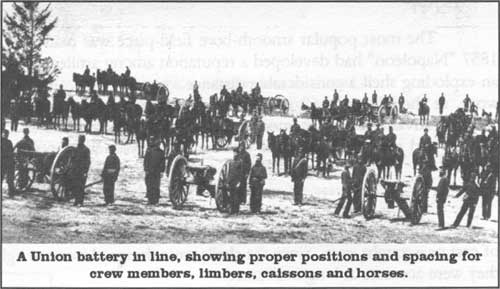
|
| Union artillery battery in line |
The most popular smoothbore cannon for both the Union and Confederate
artillery was the 12-pounder Model 1857, Light, commonly called "Napoleon". The Model 1857 was of lighter weight than the
previous 12-pounder guns, and could be pulled by a six-horse draft, yet offered the heavier projectile payload of the larger
bore. It is sometimes called, confusingly, a "gun-howitzer" (because it possessed characteristics of both gun and howitzer).
The twelve-pounder "Napoleon" smoothbore cannon was named after Napoleon
III of France and was widely admired because of its safety, reliability, and killing power, especially at close range. In
Union Ordnance manuals it was referred to as the "light 12-pounder gun" to distinguish it from the heavier and longer 12 pounder
gun (which was virtually unused in field service.) It did not reach America until 1857. It was the last cast bronze gun used
by an American army. The Federal version of the Napoleon can be recognized by the flared front end of the barrel, called the
muzzle-swell. It was, however, relatively heavy compared to other artillery pieces and difficult to move across rough terrain.
Confederate Napoleons were produced in at least six variations, most of
which had straight muzzles, but at least eight catalogued survivors of 133 identified have muzzle swells. Additionally, four
iron Confederate Napoleons produced by Tredegar Iron Works in Richmond have been identified, of an estimated 125 cast. In
early 1863, Robert E. Lee sent the majority of the Army of Northern Virginia's bronze 6-pounder guns to Tredegar to be melted
down and recast as Napoleons. Copper for casting bronze pieces became increasingly scarce to the Confederacy throughout the
war and became acute in November 1863 when the Ducktown copper mines near Chattanooga were lost to Union forces. Casting of
bronze Napoleons by the Confederacy ceased and in January 1864 Tredegar began producing iron Napoleons.
Commonly referred to as the "Napoleon", the M1857 12-pdr. Napoleon bronze
smoothbore cannon fired a twelve-pound ball and was considered a light gun through each weighed an average of 1,200 pounds.
This powerful cannon could fire explosive shells and solid shot up to a mile and charges of canister to 300 yards with
accuracy. The Napoleon was a favorite amongst some Northern artillerists because of its firepower and reliability. Two Union
batteries armed with Napoleons at Gettysburg were very effective in holding back Confederate infantry attacks and knocking
down opposing Southern batteries. Battery G, 4th U.S. repeatedly slowed Confederate infantry attacks against the Eleventh
Corps lines on July 1, while Captain Hubert Dilger's Battery G, 1st Ohio Light Artillery almost annihilated two Confederate
batteries with accurate and punishing counter-battery fire at long distance. Most Union Napoleons were manufactured in Massachusetts
by the Ames Company and the Revere Copper Company. Confederate industry replicated the Napoleon design at several foundries
in Tennessee, Louisiana, Mississippi, Virginia, Georgia, and South Carolina. The Confederate design differed slightly from
Union-made guns but fired the same twelve pound shot, shell and canister rounds used in Union manufactured guns.
| Horses died in great numbers on the battlefield |
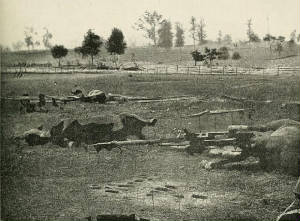
|
| Dead horses on the Civil War battlefield |
The howitzer was a short-barreled smoothbore artillery piece designed to
fire large projectiles at high trajectories.
Howitzers were short-barreled guns that were optimized for firing
explosive shells in a high trajectory at nearby concealed targets, but also for spherical case shot and canister, over a shorter
range than the guns. Howitzers were considered the weapon of choice when the
opposing forces were concealed behind terrain features or fortifications. Howitzers used lower powder charges than guns of
corresponding caliber. Field howitzer calibers used in the Civil War were 12-pounder (4.62 inch bore), 24-pounder (5.82 inch
bore), and 32-pounder (6.41 inch bore). Most of the howitzers used in the war were bronze, with notable exceptions of some
of Confederate manufacture.
(Right) Horses, as large animals, made large targets. Intentionally
or accidentally, the horse was often caught between the warring sides and the result was catastrophic. Because cavalry
and artillery relied heavily on the procurement of strong, fit horses the demand quickly outstripped the meager supply. Both
armies, however, resorted to employing mules and others pack animals as substitutes. Several thousand horses were
killed during battle, but thousands also succumbed to the excessive demands of Civil War. In the midst of a single
major battle, it was the norm to view hundreds of dead horses scattered across the battlefield. It was also commonplace
to observe several horses simply collapse to the ground and die from exhaustion.
During battle, when horses fell dead constantly, soldiers sought shelter behind the dead animals. See also Civil War Horses.
Coupled
to the 6-pounder smoothbore field gun in allocations of the pre-war Army, the 12-pounder field howitzer was
represented by Models of 1838 and 1841. With a light weight and respectable projectile payload, the 12-pounder was only cycled
out of the Union field army inventories as production and availability of the 12-pounder "Napoleon" replaced it, but the howitzer
remained in Confederate service for the duration of the conflict.
As with the corresponding heavy field guns, the heavier Howitzers were available
in limited quantities early in the war. Both Federal and Confederate contracts list examples of 24-pounders delivered during
the war, and surviving examples exist of imported Austrian types of this caliber used by the Confederates. These 24-pounder
Howitzers found use in the "reserve" batteries of the respective armies, but were gradually replaced over time with heavy
rifled guns. Both the 24- and 32-pounders were more widely used in fixed fortifications.
Principal characteristics of common smoothbore Field Artillery
| M1857 Napoleon Smoothbore Cannon |
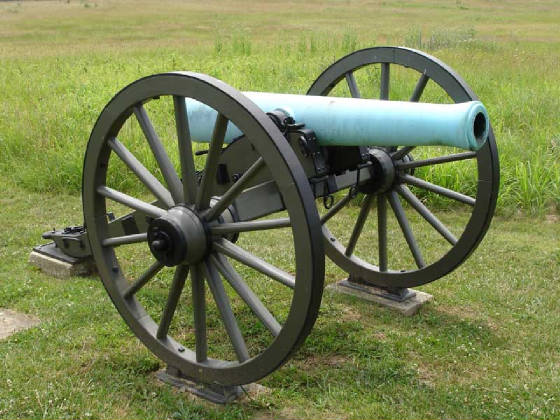
|
| Model 1857 12-pounder Napoleon Light |
| Smoothbore Artillery |
|
Field Artillery
Piece |
Bore
diameter
(inches) |
Material |
Length
of tube
(inches) |
Weight
of tube
(pounds) |
Weight of
projectile
(pounds) |
Weight of
charge
(pounds) |
Muzzle
velocity
(ft./sec.) |
Range at 5°
elevation
(yards) |
M1841 6-pdr. Gun
. |
3.67 |
Bronze |
60.0 |
884 |
6.10 |
1.25 |
1,439 |
1,523 |
M1841 12-pdr. Gun
. |
4.62 |
Bronze |
78.0 |
1,757 |
12.30 |
2.50 |
1,486 |
1,663 |
M1841 12-pdr.
Howitzer |
4.62 |
Bronze |
53.0 |
788 |
*8.90 |
1.00 |
1,054 |
1,072 |
M1841 24-pdr.
Howitzer
|
5.82 |
Bronze |
64.0 |
1,318 |
*18.40 |
2.00 |
1,060 |
1,322 |
M1841 32-pdr.
Howitzer |
6.40 |
Bronze |
75.0 |
1,920 |
*25.60 |
2.50 |
1,100 |
1,504 |
M1841 12-pdr.
Mountain Howitzer |
4.62 |
Bronze |
32.9 |
220 |
*8.90 |
0.50 |
650 |
900 |
M1857 12-pdr. Napoleon
. |
4.62 |
Bronze |
66.0 |
1,227 |
12.30 |
2.50 |
1,440 |
1,619 |
* Weight of shell.
Rifled Artillery
The cannon made the transition from smoothbore
firing cannonballs to rifled firing shells in the 19th century. Rifling is the process of making helical grooves in the barrel
of a gun or firearm, which imparts a spin to a projectile around its long axis. This spin serves to gyroscopically stabilize
the projectile, improving its aerodynamic stability and accuracy. The Civil War was the first major war to see the use of
rifled artillery. Rifling gave the guns greater velocity, range, accuracy and penetrating power, making smoothbore siege guns
obsolete. Rifled guns were very effective against stone, brick, and masonry fortifications, but considered ineffective against
earthen field works and in trench warfare. A rifled barrel, having spiral grooves or polygonal rifling, imparts a gyroscopic
spin to the projectile that stabilizes it in flight and prevents it from tumbling. This does two things; first, it increases
the accuracy of the projectile by eliminating the random drift due to the Magnus effect, and second, it allows a longer, heavier
bullet to be fired from the same caliber barrel, increasing range and power. In the eighteenth century, the standard infantry
arm was the smoothbore musket; by the nineteenth century, rifled barrels became the
norm, increasing the power and range of the infantry weapon significantly.
| looking into the barrel |
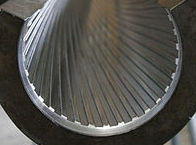
|
| rifling grooves |
The 3-inch (76 mm) rifle, aka 3-Inch Ordnance rifle, was
the most widely used rifled gun during the war. Invented by John Griffen, it was extremely durable, with the barrel made of
wrought iron, primarily produced by the Phoenix Iron Company of Phoenixville, Pennsylvania. There are few cases on
record of the tube fracturing or bursting, a problem that plagued other rifles made of brittle cast iron. Initially, some
skeptical politicians and officers thought, would damage can this 3-inch rifle inflict? The rifle, however, had exceptional
accuracy. During the Battle of Atlanta, a Confederate gunner was quoted: "The Yankee three-inch rifle was a dead shot at any
distance under a mile. They could hit the end of a flour barrel more often than miss, unless the gunner got rattled."
This sleek weapon was also called the 3-inch Ordnance Rifle and was designed
by John Griffen, superintendent of the Safe Harbor Iron Works in Pennsylvania. This iron gun was similar in length of
the Parrott Rifle, fired an elongated shell, and was deadly accurate up to a mile. Much lighter than the Napoleon, the gun
weighed an average of 800 pounds and could be easily transported and manhandled by its crew. Only a limited number of
the Ordnance rifles were produced at Confederate arsenals.
Principal characteristics of common rifled Field Artillery
| Civil War Artillery and the Parrott Rifle |
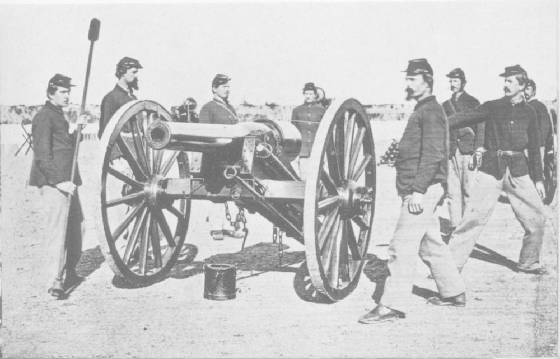
|
| 20-pounder Parrotts, 1st Conn. Artillery, Ft. Richardson, Arlington Heights, VA. |
| Rifled Artillery |
|
Field Artillery
Piece |
Bore
diameter
(inches) |
Material |
Length
of tube
(inches) |
Weight
of tube
(pounds) |
Weight of
projectile
(pounds) |
Weight of
charge
(pounds) |
Muzzle
velocity
(ft./sec.) |
Range at 5°
elevation
(yards) |
M1861 10-pdr.
Parrott Rifle |
*2.90 |
Cast
Iron |
74.0 |
890 |
9.50 |
1.00 |
1,230 |
1,850 |
M1862 20-pdr.
Parrott Rifle
|
3.67 |
Cast
Iron |
84.0 |
1,750 |
20.00 |
2.00 |
1,250 |
1,900 |
M1861 3-inch
Ordnance Rifle
|
3.00 |
Wrought
Iron |
69.0 |
820 |
9.50 |
1.00 |
1,230 |
1,830 |
M1861 14-pdr.
James Rifle
|
3.67 |
Bronze |
60.0 |
875 |
12.00 |
.75 |
1,000 |
1,700 |
M1861 24-pdr.
James Rifle |
4.62 |
Bronze |
78.0 |
1,750 |
24.00 |
1.50 |
1,000 |
1,800 |
M1861 12-pdr.
Blakely Rifle
|
3.40 |
Steel |
59.0 |
800 |
10.00 |
1.00 |
1,250 |
1,850 |
6-pdr. Whitworth
Breechloading Rifle |
2.15 |
Steel |
70.0 |
700 |
6.00 |
1.00 |
1,550 |
2,750 |
12-pdr. Whitworth
Breechloading Rifle |
2.75 |
Steel |
104.0 |
1,092 |
12.00 |
1.75 |
1,500 |
2,800 |
12-pdr. Whitworth
Muzzleloading Rifle |
2.75 |
Steel |
84.0 |
1,000 |
12.00 |
2.00 |
1,600 |
3,000 |
6-pdr. Wiard Rifle
.
|
2.56 |
Steel |
56.0 |
600 |
6.00 |
0.60 |
1,300 |
1,800 |
10-pdr. Wiard Rifle
. |
3.00 |
Steel |
58.0 |
790 |
10.00 |
1.00 |
1,230 |
1,850 |
3-inch Armstrong
Muzzleloading Rifle |
3.00 |
Steel |
76.0 |
996 |
12.00 |
1.25 |
1,350 |
2,200 |
3-inch Armstrong
Breechloading Rifle |
3.00 |
Steel |
83.0 |
918 |
12.00 |
1.25 |
1,300 |
2,100 |
* The M1861 Parrott had a 2.90 inch bore diameter, while the M1863
Parrott had a 3.00 inch bore diameter.
Projectiles
Four basic types of projectiles were employed by Civil War field artillery:
solid shot, shells, case shot, and canister. Ammunition came in wide varieties, designed to attack specific targets.
A typical Union artillery battery (armed with six 12-pounder Napoleons) carried the following ammunition going into battle:
288 shot, 96 shells, 288 spherical cases, and 96 canisters.
| Civil War Artillery and Cannon Ammunition |
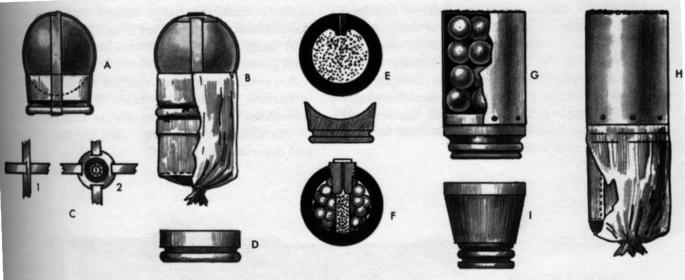
|
| Types of Artillery Projectiles |
(Right)
A) Solid shot attached to wooden sabot with straps.
B) Shell-complete
fixed round. Cartridge bag tied to sabot. Paper bag in place.
C) Arrangement of straps for shot (1) and shell (2) (opening
allowed for fuze).
D) Cartridge block for separate cartridge. Projectile and powder charge for rounds for guns larger
than 12-pounders were usually loaded separately.
E) Shell and sabot.
F) Spherical case: 12-pounder. contained 4.5-ounce
burster and 78 musket balls.
G) Canister: 12-pounder contained 27 cast-iron shots, average weight is 0.43 pounds in tin
case, nailed to sabot.
H) Complete fixed round of canister. Paper bag was torn off before loading.
I) Tapered sabot
for howitzers (powder chamber in howitzers was smaller than the bore).
Shot was a solid projectile that included no explosive charge. For a smoothbore,
the projectile was a round "cannonball". For a rifled gun, the projectile was referred to as a bolt and had a cylindrical
or spherical shape. In both cases, the projectile was used to impart kinetic energy for a battering effect, particularly effective
for the destruction of enemy guns, limbers and caissons, and wagons. It was also effective for mowing down columns of infantry
and cavalry and had psychological effects against its targets. Despite its effectiveness, many artillerymen were reluctant
to use solid shot, preferring the explosive types of ordnance. With solid projectiles, accuracy was the paramount consideration,
and they also caused more tube wear than their explosive counterparts. While
rifled cannon had much greater accuracy on average than smoothbores, the smoothbores had an advantage firing round shot relative
to the bolts fired from rifled pieces. Round shot could be employed in ricochet or rolling fire extending the depth and range
of its effect on land or water while bolts tended to dig in rather than ricochet.
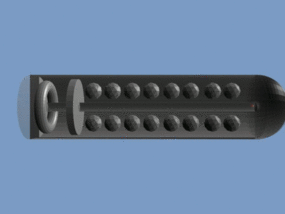
|
| Case, aka Shrapnel |
Shell
Shells included an explosive charge and were designed to burst into fragments
in the midst of enemy infantry or artillery. For smoothbores, the projectile was referred to as "spherical shell". Shells
were more effective against troops behind obstacles or earthworks, and they were good for destroying wooden buildings by setting
them on fire. They were ineffective against good quality masonry. A primary weakness of shell was that it typically produced
only a few large fragments, the count increasing with caliber of the shell. A Confederate mid-war innovation perhaps influenced
by British ordnance/munition imports was the "polygonal cavity" or "segmented" shell which used a polyhedral cavity core to
create lines of weakness in the shell wall that would yield more regular fragmentation patterns—typically 12 similarly
sized fragments. While segmented designs were most common in spherical shell, it was applied to specific rifled projectiles
as well. Spherical shell used time fuzes, while rifled shell could use
timed fuze or be detonated on impact by percussion fuze. Fuze reliability was a concern; any shell that buried itself into
the earth before detonating had little anti-personnel effectiveness. However, large caliber shells, such as the 32-pounder
spherical were effective at breaching entrenchments.
Case (or shrapnel)
Case (or "spherical case" for smoothbores) were anti-personnel projectiles
carrying a smaller burst charge than shell, but designed to be more effective against exposed troops. While shell produced
only a few large fragments, case was loaded with lead or iron balls and was designed to burst above and before the enemy line,
showering down many more small but destructive projectiles on the enemy. The effect was analogous to a weaker version of canister.
With case the lethality of the balls and fragments came from the velocity of the bursting projectile itself—the small
burst charge only fragmented the case and dispersed the shrapnel. The spherical case used in a 12-pounder Napoleon contained
78 balls. The name shrapnel derives from its inventor, Henry Shrapnel. The
primary limitations to case effectiveness came in judging the range, setting the fuze accordingly, and the reliability and
variability of the fuze itself.
Canister (or case-shot)
Canister shot was the deadliest type of ammunition, consisting of a thin
metal container loaded with layers of lead or iron balls packed in sawdust. Upon exiting the muzzle, the container disintegrated,
and the balls fanned out as the equivalent of a shotgun blast. The effective range of canister was only 400 yards (370 m),
but within that range dozens of enemy infantrymen could be mowed down. Even more devastating was "double canister", generally
used only in dire circumstances at extremely close range, where two containers of balls were fired simultaneously. Canister shot, also known as case shot, was a kind of anti-personnel ammunition used
in cannons. Canister shot was packaged in a tin or brass container, possibly
guided by a wooden sabot. Canister balls did not have to punch through the wooden hull of a ship, so were smaller and more
numerous. The later shrapnel shell was similar, but with a much greater range. Canister also played a key role in dispersing
the troops assigned to support Pickett's Charge during the Battle of Gettysburg in July 1863.
| Cannon headshot from canister shot |

|
| Canister ball headshot, 12-pounder field howitzer |
(Right) Result of a headshot
caused by a single iron canister ball fired from the 12-pounder field howitzer. This skull was discovered in 1876 on Morris
Island, South Carolina, near the site of Battery Wagner, a powerful earthwork fort that had protected the entrance to Charleston
Harbor during the Civil War. The skull belonged to a man of African descent—a soldier of the famous 54th Massachusetts
Volunteers, which had led the assault on Wagner on the night of July 18, 1863. Of approximately 600 men who made the charge,
256 were killed, wounded, or missing. From the size of the wound, and the remains of the projectile itself, it can be determined
what type of munition hit this man: an iron canister ball from one of two 12-pounder field howitzers known to have been used
in the repulse of that attack. The 54th Massachusetts Volunteers was not the first black regiment in the Civil War, nor was
it the first to fight. However, it was the first black regiment raised entirely of free men enrolled on exactly the same footing
as white troops and the first to engage in a major action well-covered by the national press. Its gallant conduct in the doomed assault on Battery Wagner, at Charleston, South Carolina, on July 18, 1863, electrified
the nation and proved once and for all that the black man, given the opportunity, could learn the soldier’s trade, and
fight as well as any white man.
Grapeshot
Grapeshot was a type of shot that is not one solid element, but a mass of small metal balls or
slugs packed tightly into a canvas bag. It was used both in land and naval warfare. When assembled, the balls resembled a
cluster of grapes, hence the name. On firing, the balls spread out from the muzzle, giving an effect similar to a giant shotgun.
Grapeshot was devastatingly effective against massed infantry at short range. It was used to savage massed infantry charges
quickly. Cannons would fire solid shot to attack enemy artillery and troops at longer range and switch to grape when they
or nearby troops were charged. Grapeshot was the predecessor of, and a variation on, canister,
in which a smaller number of larger metal balls were arranged on stacked iron plates with a threaded bolt running down the
center to hold them as a unit inside the barrel. It was used at a time when some cannons burst when loaded with too much gunpowder,
but as cannons got stronger, grapeshot was replaced by canister. A grapeshot round (or "stand") used in a 12-pounder Napoleon
contained 9 balls, contrasted against the 27 smaller balls in a canister round. By the time of the Civil War, grapeshot was
obsolete and largely replaced by canister. The period Ordnance and Gunnery work states that grape was excluded from "field
and mountain services." Few, if any, rounds were issued to field artillery batteries. Scattershot was an improvised form of
grapeshot which uses chain links, nails, shards of glass, rocks or other similar objects as the projectiles. Although scattershot
can be cheaply made, it was less effective than grapeshot due to the lack of uniformity in the projectiles' mass, shape, material,
and resultant ballistics.
Field Artillery
Field artillery was a category of light, mobile artillery used to support armies in the field. Field
pieces were specialized for mobility, tactical proficiency, and both short and long range engagements. Field artillery
generally supported infantry and cavalry on the battlefield.
Although Parrott rifled-guns (Parrott Class) and Napoleon smoothbores were coveted
by both Union and Confederate forces, the Model 1861 3-inch Wrought Iron rifle, aka Ordnance Rifle, was the most common rifled
field piece on the battlefield, while the Model 1857 Napoleon, Light, was the most widely used artillery
piece during the Civil War.
Robert Parker Parrott (1804–77), an 1824 graduate of the United States Military Academy,
developed a new form of rifled artillery using a cast iron barrel with a reinforcing wrought iron band around the breech.
He initially produced 2.9-inch (10-pounder) and 3.67-inch (20-pounder) rifles for the field artillery. He later produced
four larger rifled guns that were used as siege artillery. These heavy Parrott rifles became the mainstays of the Federal
siege train. In early 1863, Robert E. Lee sent nearly all of the Army of Northern Virginia's obsolete (Mexican-American War
era) bronze 6-pounder guns to Tredegar to be melted down and recast as Napoleons.
The principal guns widely employed in the field and their respective characteristics
| Most widely used field artillery of the Civil War |
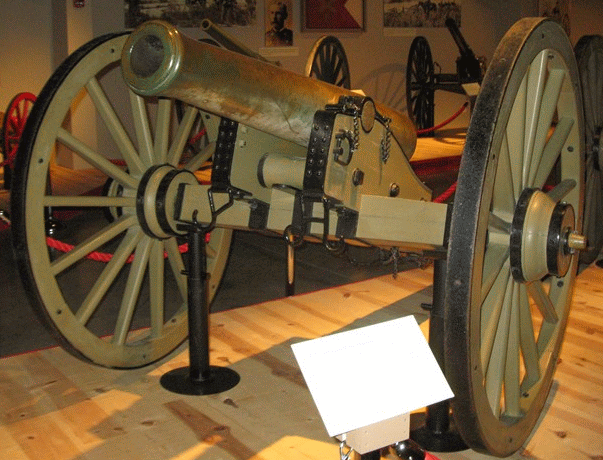
|
| U.S. Model 1857 12-pounder Napoleon smoothbore cannon |
| Field
Artillery Weapons and Characteristics |
|
Field Artillery
Piece |
Bore
diameter
(inches) |
Material |
Length
of tube
(inches) |
Weight
of tube
(pounds) |
Weight of
projectile
(pounds) |
Weight of
charge
(pounds) |
Muzzle
velocity
(ft./sec.) |
Range at 5°
elevation
(yards) |
| 6-pounder Gun |
3.67 |
Bronze |
60.0 |
884 |
6.10 |
1.25 |
1,439 |
1,523 |
| M1857 12-pounder "Napoleon" |
4.62 |
Bronze |
66.0 |
1,227 |
12.30 |
2.50 |
1,440 |
1,619 |
| 12-pounder Howitzer |
4.62 |
Bronze |
53.0 |
788 |
8.90 |
1.00 |
1,054 |
1,072 |
| 12-pounder Mountain Howitzer |
4.62 |
Bronze |
33.0 |
220 |
8.90 |
.50 |
------ |
1,005 |
| 24-pounder Howitzer |
5.82 |
Bronze |
64 .0 |
1,318 |
18.40 |
2.00 |
1,060 |
1,322 |
| 10-pounder Parrott Rifle
|
2.9 & 3.0 |
Iron |
74.0 |
890 |
9.50 |
1.00 |
1,230 |
1,850 |
| 3-inch Ordnance Rifle |
3.00 |
Wrought Iron |
69.0 |
820 |
9.50 |
1.00 |
1,215 |
1,830 |
| *14-pounder James Rifle |
3.80 |
Bronze |
60.0 |
875 |
14.00 |
1.25 |
------ |
1,530 |
| 20-pounder Parrott Rifle |
3.67 |
Iron |
84.0 |
1,750 |
20.00 |
2.00 |
1,250 |
1,900 |
12-pounder Whitworth Breechloading
Rifle
. |
2.75 |
Iron/Steel |
104.0 |
1,092 |
12.00 |
1.75 |
1,500 |
2,800 |
Italics denotes data for shell, not shot.
* Hazlett, pp. 151-152. This is for Hotchkiss shell
of 14lb @ 5 degrees. Hazlett used the only primary source: Abbot's Siege Artillery, p. 116. Hazlett also determined bore and
Type I based on text description and shell weight--matching recorded weights of modern recoveries (see Dickey pp. 137-139,143-146.)
Coles' data table and many others based on Peterson's 1959 book have impossibly small powder charge for range and weight given.
Later 14-pounder James types with Ordnance profile had longer barrels with 7.5" greater bore length (13% increase) and therefore
would have increased range.
The M1857 12-pounder Napoleon was a bronze smoothbore with an effective
range of 1,000 yards and a range of 1,619 yards at five degrees elevation. It fired solid shot, shell, case shot and canister
rounds with a 2 1/2 lb. charge of powder. The gun with its carriage and equipment weighed 2,500 lbs. and was served by a crew
of eight. (Casualties of disease and battle often reduced the crew to the minimum of three men.) While the Model 1857 12-pounder,
Light, commonly known as "Napoleon," was the most widely used "smoothbore field cannon" during the Civil War, the most
widely employed "rifled field piece" was the 3-inch Ordnance rifle, commonly known as 3-inch Wrought Iron rifle. Both
the M1857 Napoleon and 3-in. Ordnance rifle were coveted by both armies.
|

|

|

|

|
(Left) Union officers with a 3-inch Ordnance rifle. The 3-inch Ordnance
rifle, aka 3-inch Wrought iron rifle, was the most employed rifled field piece during the Civil War. Known
for its reliability and accuracy, the 3-inch Ordnance rifle was fielded by the artillery branches of both armies. Crafted
from hammer-welded, machined iron the ordnance rifle typically fired 8- or 9-pound shells, as well as solid shot, case, and
canister. Due to the manufacturing process involved, Union-made rifles tended to perform better than Confederate models. (Center)
A Union battery of 20-pounder Parrott rifles in the field. Designed by Robert Parrott of the West Point Foundry (NY), the
Parrott rifle was deployed by both the US Army and US Navy. Parrott rifles were produced in 10- and 20-pounder models for
use on the battlefield and as large as 200-pounders for use in fortifications. Parrotts were easily distinguished by
the reinforcing band around the breech of the gun. (Right) An African-American soldier guards a 12-pounder Napoleon.
The 12-pounder Napoleon Light, as it was also known, was the most widely used smoothbore field cannon used during
the conflict. Designed and named for the French Emperor Napoleon III, the Napoleon was the workhorse gun of the Civil War
artillery. Cast of bronze, the smoothbore Napoleon was capable of firing a 12-pound solid ball, shell, case shot, or canister.
Both sides deployed this versatile gun in large numbers.
| The highly coveted Union field artillery, Napoleon |
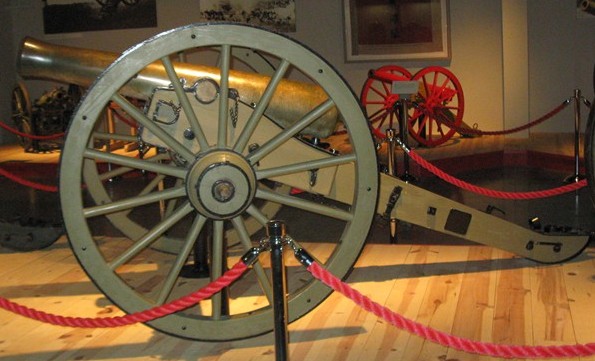
|
| Union Model 1857 12-pounder Napoleon gun-howitzer |
Model 1857 12-pounder Napoleon Light Field Gun
The M1857 Napoleon Light, employed in mass numbers by both the
Union and Confederate armies, was the most widely used artillery piece during the Civil War. While the gun was the
most popular, common, and deadly field piece, as a smoothbore, it also subjected the infantry lines to devastating canister
at close range. Developed under the auspices of Louis Napoleon of France, it first appeared in the United States inventory in
1857. In the North, the smoothbore Napoleon was officially designated the "light 12-pounder gun". A Napoleon fired a 12.3
lb projectile and had a maximum effective range of approximately 1,600 yards. Union Napoleons had a slight swell at the muzzle
(Confederate model had no pronounced swell) of the 4.62 inch bore. The barrel with its carriage weighed 2,445 pounds,
light enough to be hauled by men for short distances, however, the usual method of transportation was by a six-horse team
with a driver aside one of each pair of horses.
The Confederacy produced numerable Napoleons, the majority out of bronze.
Confederate made pieces were included iron variants with a band-reinforced breech. The copper that was used in manufacturing
the bronze Napoleons at the famous Tredegar Iron Works of Richmond, Virginia, came primarily from one source: The Ducktown
mines near Chattanooga, Tennessee. Each Napoleon produced by Tredegar, and presumably most other foundries, required over
1000 pounds of copper. At the recommendation of General Robert E. Lee, bronze cannons that fired lighter shot, such as the
6-pounder, were melted down and rebuilt as Napoleons, which were more effective weapons.
Unfortunately for the Confederacy, the Ducktown mines were captured in November
of 1863 by Union forces. This ended bronze Napoleon production in the South, but this did not end Napoleon production,
however. In 1864, Tredegar started to produce iron Napoleons. These were manufactured in a similar fashion as the Parrott
rifles, out of cast iron with wrought iron reinforcing bands. While 120 of these guns were produced by the South before the
end of the war, this method of manufacturing had its disadvantages.
Artillerymen favored bronze Napoleons because their barrels were stronger
and safer than guns made of iron. Bronze pieces had a comparatively lower rate of muzzle bursting incidents when
fired, thus minimizing casualties to the crew. A Napoleon was able to
fire all of the four basic types of ammunition. The solid shot, shell, and case rounds were all spherical and were used against
enemies at distances greater than 600 yards. For shorter distances the gun was loaded with canister, which turned it into
a giant shotgun with lethal effects. Firing canister, the Napoleon probably inflicted more casualties than all other Civil
War era artillery pieces combined.
| Confederates made 6 variants of the Napoleon |
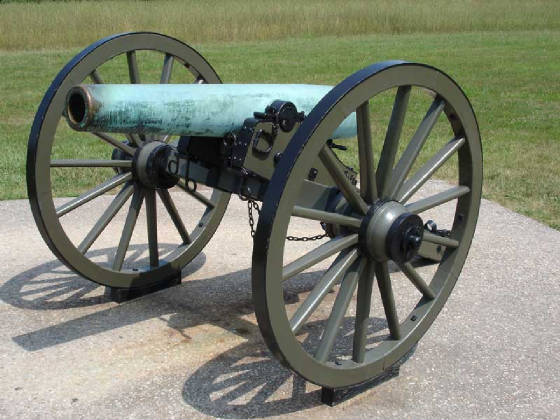
|
| Confederate 1857 12-pounder Napoleon Light |
Model: 1857 12-pounder "Napoleon" Light
smoothbore gun-howitzer
Class: Field artillery, light
Type: Smoothbore gun-howitzer
Manufactured: USA and CSA; 1857 to 1863
Tube Composition: Bronze or cast iron
Bore Diameter: 4.62 inches
Standard Powder Charge: 2.5 lbs. Black Powder
Projectiles: 12 lb. solid shot, spherical case, common shell,
canister
Muzzle Velocity: 1,485 fps
Effective Range (at 5°): 1,619 yards
Tube Length: 66 inches
Bronze Tube Weight: 1,227 lbs.
Iron Tube Weight: 1,249 lbs.
Total Weight (Gun & Carriage): 2,350 lbs.
Carriage Type: No. 2 Field Carriage (1,125 lbs.), 57" wheels
Horses Required to transport: 6
Production: approx. 1100
Cost in 1861 Dollars: $490(US) $ 565(CS)
Cost in 1864 Dollars: $614(US) $1840(CS)
Notes: Named after French Emperor Louis Napoleon III
Model 1861 3-inch Ordnance Rifle
The Model 1861 3-inch Wrought Iron rifle, aka Ordnance Rifle, was the most
common rifled field piece on the battlefield.
Originally known as the "Griffen Gun," after its designer, John Griffen,
the 3-inch Ordnance Rifle was manufactured at the Phoenix Iron Company in Phoenixville, Pennsylvania, and it was adopted by
the Federal Ordnance Department in early 1861. The design of this rifle, soon a favorite with artillerists in both armies,
is recognized by the complete absence of any discontinuities in the surface of the gun. It was also a major step forward in
material, being made entirely of wrought iron.
To manufacture the Ordnance Rifle,
strips of wrought iron were hammer-welded in criss-crossing spiral layers around a mandrel; this was then bored out and the
finished product lathe turned into shape. Though time consuming and expensive to produce, the result was a singularly
tough and accurate weapon. Less precise machining and lower-grade iron yielded their Confederate counterparts more imperfections.
While the Napoleon was the weapon of choice for short-range fighting,
the Ordnance Rifle was valued for its long range accuracy. A one lb charge of gunpowder could accurately propel a 10 lb elongated
shell a distance of 2,000 yards at only 5 degrees of elevation. Longer distances, but less accuracy, could be achieved with
higher elevations. Artillerymen preferred this piece because it did not have the tendency to explode upon firing as cast iron
cannon did. This gun is one-hundred pounds lighter than the 10 pdr. Parrott Rifle (800 lbs to the Parrott's 900) which made
it highly mobile. For this reason, it was the preferred weapon of the fully mounted Horse Artillery.
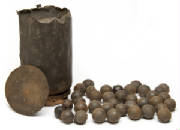
|
| Canister Shot |
The North produced more than 1,000 3-inch Ordnance Rifles during the war
at a cost of approximately $350 each, and were considered prized captures by the South.
The original design was patented in 1855 and was not quite what we know
as the ordnance rifle; there was an evolutionary process both in achieving the final smooth profile of the piece, and the
wrought iron, wound and welded in criss-crossing spirals in the original patent, was apparently done in sheets or plates for
the final form of the gun. The Ordnance Rifle was manufactured at the Phoenix Iron Company in Phoenixville, Pennsylvania.
It was adopted by the Federal Ordnance Department in early 1861. Other versions of this weapon were produced in 1862 and 1863
by different companies, but this is the only weapon officially known as the Ordnance Gun. The Confederates also produced their
own version of this gun.
This weapon could accurately fire Schenkl and Hotchkiss shells approximately
2,000 yards at five degrees elevation, using a one pound charge of powder. The Hotchkiss shell was the most common projectile
fired from the Model 1861. It was designed by Benjamin and Andrew Hotchkiss as a three piece shell - nose (containing the
powder chamber), sabot (soft lead band fitting into an intention in the middle of the shell), and an iron forcing cup at the
base (which forced the lead sabot to expand upon firing).
The other shell for this rifle was the Schenkl. This was a cone shaped projectile
which employed ribs along the taped base. The sabot was made of papier-mâché' which was driven up the taper by the force of
the gas produced upon firing. The sabot then expanded and caught the rifling in the tube.
| 3-inch Ordnance Rifle |
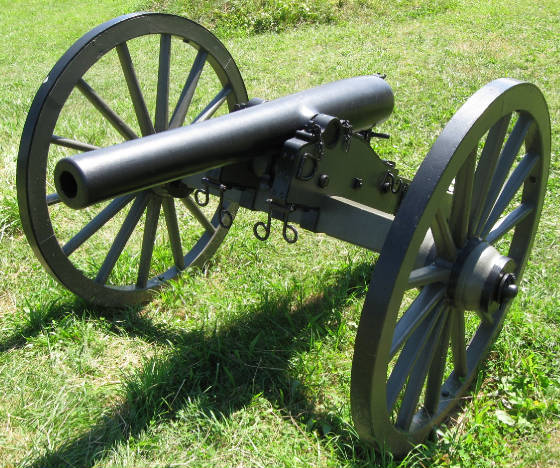
|
| 3-Inch Wrought Iron Rifle |
This gun was sometimes erroneously referred to as a "Rodman." The process
used by Thomas Rodman in casting the Columbiads was not used in producing the wrought iron barrel of the Ordnance gun. Rodman
was also absent during research and development, as well as final design and production of this gun.
Model: 3-Inch Wrought Iron Rifle
Class: Field artillery, light
Type: Rifled-gun
Manufactured: USA; 1861 to 1865
Tube Composition: Wrought iron
Bore Diameter: 3.0 inches
Rifling Type: 7 rifle grooves
Standard Powder Charge: 1 lb. Black Powder
Projectiles: 10 lb. Bolts, 8 to 9 lbs. Hotchkiss or Schenkel
shells
Muzzle Velocity: 1,215 fps
Effective Range (at 5°): 1,850 yards
Tube Length: 73 inches
Tube Weight: 816 lbs.
Total Weight (Gun & Carriage): 1,720 lbs.
Carriage Type: No. 1 Field Carriage (900 lbs.), 57" wheels
Horses Required to Pull: 6
No. in North America: approx. 1000+
Cost in 1861 Dollars: $330 (US)
Cost in 1865 Dollars: $450 (US)
Invented By: John
Griffen in 1855
US Casting Foundry: Phoenix Iron Company, Phoenixville PA
CS Casting Foundry: Tredegar
Iron Works, Richmond VA (CS castings were known as: 3-inch Iron Field
Rifles)
Notes: Lightest and strongest rifled tube. Sometimes incorrectly
referred to as a Rodman gun.
Model 1841 6-pounder Smoothbore Field Gun
Model 1841 6-pounder Gun was the workhorse of the Mexican-American War.
Although considered obsolete by 1861 standards, battlefield necessity pressed this gun into service immediately.
The 6-pounder field gun was a lightweight, mobile piece that was a favorite
of the field artillery in the first half of the nineteenth century. This popular workhorse of the Mexican War era was regarded
as obsolete by the Union army, but was still heavily employed by the Confederate army midway through the conflict. Field guns were produced in 6-pounder (3.67 inch bore), 9-pounder (4.2 inch bore),
and 12-pounder (4.62 inch bore) versions. Although some older iron weapons were pressed into service, and the Confederacy
produced some new iron field guns, most of those used on the battlefields were of bronze construction.
The 6-pounder field gun was well represented by bronze Models of 1835,
1838, 1839, and 1841 early in the war. Even a few older iron Model of 1819 weapons were pressed into service. Several hundred
were used by the armies of both sides in 1861. But in practice the limited payload of the projectile was seen as a shortcoming
of this weapon. From mid-war on, few 6-pounders saw action in the main field armies because, in early 1863, Robert E. Lee
sent nearly all of the Army of Northern Virginia's obsolete bronze 6-pounder guns to Tredegar to be melted down and recast
as Napoleons.
| Model 1841 6-pounder Gun |
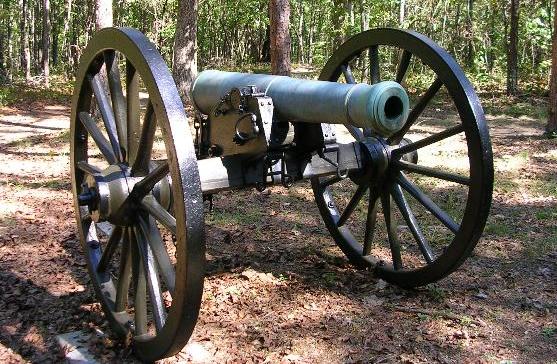
|
| Model 1841 6-pounder Smoothbore field gun |
The larger 9- and 12-pounders received insignificant representation in the field. While
the 9-pounder was still listed on Ordnance and Artillery manuals in 1861, very few were ever produced after the War of 1812
and only scant references exist to Civil War use of the weapons. The 12-pounder field gun appeared in a series of models replicating
the 6-pounder, but in far less numbers. Although the 12-pounder saw service early in the war, its major shortcoming was mobility.
The 12-pounders required an eight-horse team as opposed to the six-horse team of the lighter guns. While a
small quantity of 12-pounder field guns were rifled early in the war as experimental weapons, no field service was recorded.
Model: 1841 6-pounder Smoothbore field
gun
Class: Field artillery, light
Type: Smoothbore
Manufactured: USA, 1841 to 1863
Tube Composition: Bronze or cast iron
Bore Diameter: 3.67 inches
Standard Powder Charge: 1.25 lbs.
Projectiles: 6 lb. round balls
Effective Range (at 5°): 1,523 yards
Tube Length: 60 inches
Tube Weight: 884 lbs.
Carriage Type: No. 1 Field Carriage (900 lbs.), 57" wheels
Horses Required to Pull: 6
No. in North America: approx. 700
Notes: Workhorse of Mexican War, but considered obsolete by
Civil War
Model 10-pounder Parrott Rifle
The 10-pounder Parrott Rifle was deployed by both armies in the field and
it was manufactured with two bore sizes: 2.9-inch (Model 1861) and 3.0-inch (Model 1863). Confederate forces used both bore
sizes during the war, which added to the complication of supplying the appropriate ammunition to its batteries. Union batteries
used only the 2.9 inch Parrott, but they also employed 3" Ordnance rifles. During the 1st day of Gettysburg, three Parrott
rifles were temporarily unusable when 3" ammunition was issued to the battery by error. To standardize the ammunition, the
Model 1863 Parrott was introduced with its 3-inch (76 mm) bore.
More than fifty Confederate 10-pounder
Parrotts were manufactured at Tredegar Iron Works, in Richmond, Virginia. These guns were slightly longer, larger, and used
different variations of rifle grooves than their Federal counterparts. In addition, the reinforcing band on Tredegar Parrotts
is thicker and wider than Federal examples, and was applied by a simpler manufacturing method, known as the Brooke-banding
method. Many of the Tredegar Parrotts can be identified by a taper or bevel on the trunnion side of the reinforcing band.
| 10-pounder Parrott Rifle |
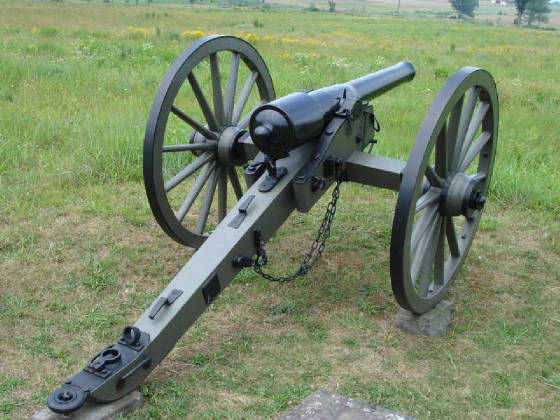
|
| 10-pounder Parrott Rifle was manufactured as Model 1861 and Model 1863 |
Model: 10-pounder Parrott Rifle
Class: Field artillery, light
Type: Rifled-gun
Manufactured: USA and CSA; 1861 to 1865
Tube Composition: Cast Iron, Wrought Iron Breech Band
Bore Diameter: 2.9 inches (Model 1861); 3.0 inches (Model 1863)
Rifling Type (US): 3 grooves, right hand gain twist
Rifling Type (CS): 3 groves right hand twist, or 12 grooves
left hand twist
Standard Powder Charge: 1 lb. Black Powder
Projectiles: 10 lb. solid bolt, case, common shell, canister
Effective Range (at 5°): 1,900 yards (1.1 miles)
Projectile Flight Time (at 5°): 8 seconds
Max Range (at 35°): 5,000 yards (2.8 miles)
Projectile Flight Time (at 35°): 21 seconds
Tube Length: 78 inches (US); 81 inches (CS)
Tube Weight: 890 lbs. (US); 1,150 lbs. (CS)
Total Weight (Gun & Carriage): 1,800 lbs. (US); 2,060 lbs.
(CS)
Carriage Type: No. 1 Field Carriage (900 lbs.), 57" wheels
Horses Required to Pull: 6
No. in North America: approx. 630
Cost in 1862 Dollars: $180 (US); $ 300 (CS)
Cost in 1865 Dollars: $187 (US); $3,000 (CS)
Invented By: Robert Parker Parrott in 1860
US Casting Foundry: West Point Foundry, Cold Springs, NY
CS Casting Foundry: Tredegar Iron Works, Richmond, VA
Notes: Inexpensive, reliable, and accurate
Model 20-pounder Parrott Rifle
| Civil War cannon ammunition |
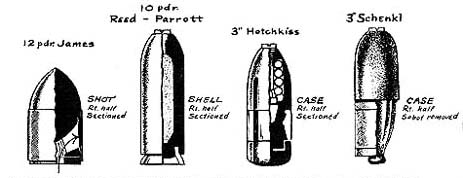
|
| Civil War artillery projectiles |
The 20-pounder Parrott was generally the largest field gun used
during the war, with the barrel alone weighing over 1,800 pounds (800 kg). Parrotts were manufactured with a combination of
cast iron and wrought iron. The cast iron improved the accuracy of the gun but was brittle enough to suffer fractures. On
the Parrott, a large wrought iron reinforcing band was overlaid on the breech. Although accurate, the Parrott had a poor reputation
for safety, and they were shunned by many artillerymen.
While the 20-pounder Parrott was considered one of the heavier artillery pieces
to engage in the field during the conflict, it was, however, occasionally joined in field service by its larger brother, the
30-pounder Parrott, which was considered by many an outstanding and accurate siege and garrison gun.
Although the 10- and 20-pounder versions
were used by Union and Confederate armies, the 10-pounder was more prevalent on the battlefield. The 20 Pounder Parrott
Rifle was one of the heaviest field artillery pieces of the war. (Occasionally, however, the 30-pounder Parrott was used as
field artillery). It was accurate, inexpensive to produce, and easy to operate. The 20-pounder, however, was prone to
bursting and injuring and killing its crew.
By December 1862, attempts were
made to eliminate the 20-pounder Parrott completely from the Army of the Potomac. It was stated that the 20-pounder
was unsatisfactory and unsafe: from the imperfection of the projectiles to subjecting the artillery crew to as much peril as
it posed to the enemy. At Antietam, some officers complained that 10% of their "20 pdr. Parrotts engaged
had suffered muzzle bursting." The gun was cumbersome for field purposes, and best used at garrisons, proclaimed another
Union officer.
Regarding the effectiveness of the 20 pdr. Parrott, while detailing
siege operations in the Richmond area, Henry L. Abbot wrote, "The 20-pounder Parrott proved to be too small to give the precision
of fire demanded of a siege gun, and to be too heavy for convenient use as a field gun. Moreover its projectiles did not seem
to take the grooves as well as those of either smaller or larger calibres. The gun was accordingly not regarded with favor."
Although the 20-pounder Parrott had a questionable safety reputation,
it served its purpose on the battlefield. While the 20-pounder Parrotts were not known for their safety, they were known for
their accuracy. The rifle was also manufactured quickly and in mass quantities, but when the Civil War concluded, the
20-pounder was retired.
| 20-pounder Parrott rifled-gun |
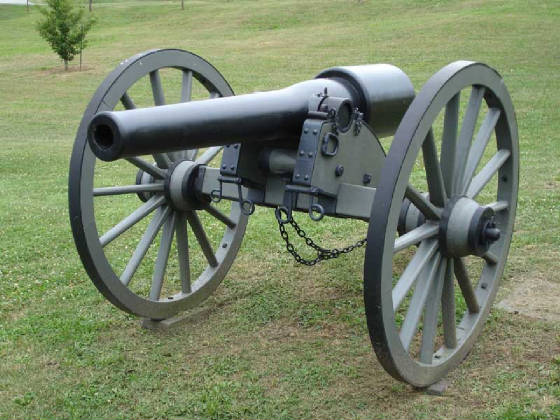
|
| 20-pounder Parrott Rifle |
Model: 20-pounder Parrott Rifle
Class: Field artillery, heavy
Type: Rifled-gun
Manufactured: USA, 1861 to 1865
Tube Composition: Cast Iron, Wrought Iron Breech Band
Bore Diameter: 3.67 inches
Rifling Type: 5 grooves, right hand gain twist
Standard Powder Charge: 2 lbs. Black Powder
Projectiles: 20 lb. solid bolt, case, common shell, canister
Effective Range (at 5°): 2,100 yards (1.1 miles)
Maximum Range (at 15°): 4,400 yards (2.5 miles)
Tube Length: 89 inches
Tube Weight: 1750 lbs. (0.8 tons)
Total Weight (Gun & Carriage): 2,925 lbs. (1.46 tons)
Carriage Type: No. 3 Field Carriage (1,175 lbs.), 57" wheels
Horses Required to Pull: 8
No. in North America: approx. 330 (Army) and 300 (Navy)
Cost in 1862 Dollars: $380(US); $550(CS)
Cost in 1865 Dollars: $387(US); $4500(CS)
Invented By: Robert Parker Parrott in 1861
US Casting Foundry: West Point Foundry, Cold Springs, NY
CS Casting Foundry: Tredegar Iron Works, Richmond, VA
Notes: Accurate, excellent for counter-battery fire, challenging
to transport, prone to bursting.
Model 14-pounder James Rifle
James rifle is a broad term to describe any artillery gun rifled
to the James pattern for use in the American Civil War. Charles T. James developed a rifled projectile and rifling system.
Early in the war there were several hundred Mexican War era 6-pounder bronze guns in service with the field artillery
and few rifled pieces available. A number of these guns were rifled to fire the 3.67" caliber James projectile. These were
classified as "rifled 6-pounder guns" or alternately as 12-pounder James rifles. Some were simply
rifled from their initial 3.67" bore, while others were reamed to 3.80" and then rifled. Reaming to 3.80" was preferred to
eliminate wear deformities from service. Nomenclature for the two sizes could be muddled and varied, but the effective descriptions
for the 3.67" are "rifled 6-pounder" or "12-pounder James rifle", while the 3.80" variant was known as the 14-pounder James
rifle. To add to the confusion new bronze (and a few iron) variants of the 3.80" bore rifle (14-pounder James rifle) were
also produced with a longer, heavier tube utilizing the Ordnance profile.
| James rifle |
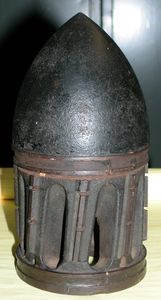
|
| James shell |
James worked with Ames
Manufacturing Company, Chicopee, Massachusetts, to produce 3.80" bore rifled cannon in at least six known variants. Collectively,
these were referred to as 14-pounder James rifles. The initial type was reaming of existing 6-pounder Model 1841 guns
to 3.80", then rifling. This eliminated any deviations from tube wear--a common problem with bronze cannon that had
already seen service. The other five types were new pieces all using the smooth curves of the Ordnance profile. The first
five variants were bronze, while the final type was iron.
Modern authorities such as Warren Ripley and James Hazlett, however, have
suggested that the term "James rifle" only properly applies to 3.80" bore field artillery pieces rifled to fire James' projectiles.
They contend that the term does not apply to smoothbores that were later rifled to take the James projectiles in 3.67" caliber
or other calibers, and that those should instead be referred to as "Rifled 6 (or other) pounder."
When hostilities commenced, the Federal army also lacked the
heavy rifled siege artillery. To fill this void, the army rifled existing smoothbore pieces with the system developed
by Charles T. James. Firing shot and shells also designed by James, these newly-rifled smoothbores excelled on the battlefield
during the April 1862 bombardment of Fort Pulaski. As the modern Parrott Class entered the field en masse, the James
Class weapons retired from the battlefield.
(Right) A James pattern solid shot. The “birdcage” at the
base would have been covered by sheet lead which, upon firing the gun, would have expanded into the grooves of the rifling
as did the lead surrounding the concavity at the breech end of the Minié ball.
The James Rifle, Type I, was merely a remanufactured Model 1841 6-pounder
that has been rifled using the James Rifling System, typically using 15 rifle grooves. These guns were not pure James Rifles,
and were externally the same as the typical M1841 6-pounder.
The James Rifle, Type II, was a bronze rifle similar in shape to the
3-inch Ordnance Rifle, and was produced by the Ames Manufacturing Company of Chicopee, Massachusetts. It usually has 7 or
10 rifle grooves and a distinctive front sight blade.
| James rifles |
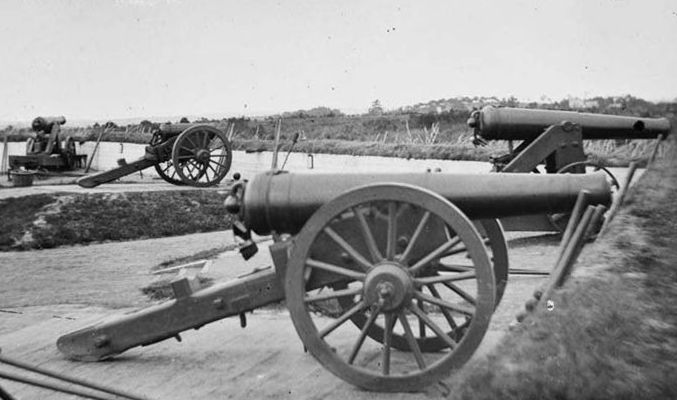
|
| Two Model 1829 32-pounder siege and garrison guns rifled with the James method in 1865 |
| Civil War Rifled Cannon, James Rifle |
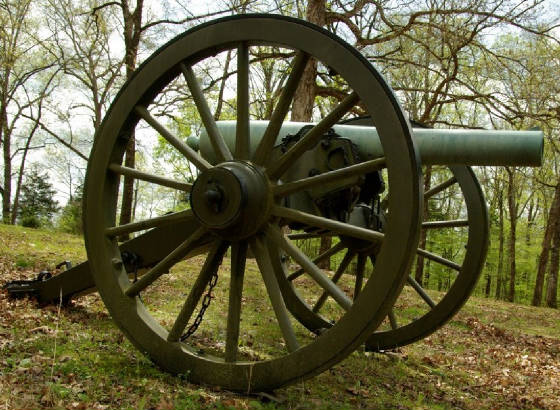
|
| 14-pounder James Rifle |
(Right) Two Model 1829 32-pounder siege and garrison guns rifled with the
James method. The siege rifle in the foreground is on a siege carriage. The one behind is on an iron, front pintle, barbette
carriage.
| Types of Civil War artillery projectiles |
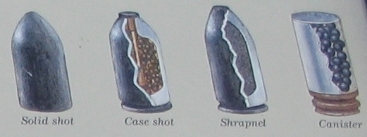
|
| Civil War artillery projectiles |
Model: 14-pounder James Rifle
Class: Field artillery, light
Type: Rifled-gun
Manufactured: USA, 1861 - 1862
Tube Composition: Bronze or sometimes steel
Bore Diameter: 3.8 inches
Standard Powder Charge: 1.25 lbs.
Projectiles: 14 lb. bolt
Tube Length: 73 inches
Tube Weight: 915 lbs.
Effective Range (at 5°): 1,530 yards
No. in North America: 400
US Casting Foundries: Ames Manufacturing Co., MA or Miles Greenwood
& Co., Cincinnati OH
Invented By: Charles Tillinghast James
Notes: Characteristics
refer to James Rifle, Type II.
Model 1841 12-pounder Howitzer
The howitzer was a type of artillery piece characterized by a relatively
short barrel and the use of comparatively small propellant charges to propel projectiles at relatively high trajectories,
with a steep angle of descent.
The Model 1841 12-pounder smoothbore howitzer was designed to fire
at higher trajectories to hit targets obscured to other artillery guns. It was part of the 1841 US artillery series which
also included the 6-pounder smoothbore gun. When the Civil War commenced, these weapons were considered obsolete, and
most were replaced with the more effective Napoleons. In Federal service, nearly all 12-pounder howitzers had been replaced
by the 12-pounder Napoleons. The Confederates, having a shortage of field pieces, maintained them in their arsenal. Howitzers
fired solid shot, spherical case, and canister.
| Civil War howitzer was a smoothbore weapon |
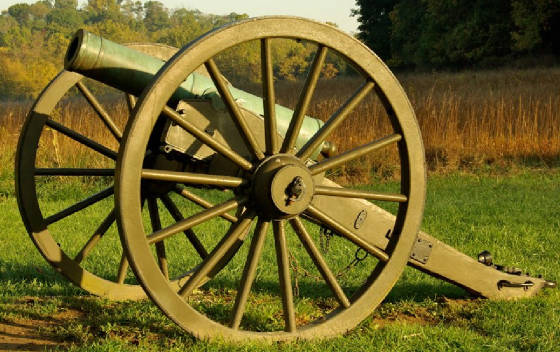
|
| 1841 12-pounder Howitzer |
The 12 pdr. Howitzer was the most effective "close range" field piece of the war for use under
400 yards. Its large shells exacted concentrated firepower, while its light weight, less than 800 lbs, made it highly mobile
and easy to position, even by hand. Because of its mobility, the piece was readily adaptable for close infantry support. The
12-pdr howitzer's weakness was its effective range of 1,000 yards, well shy of other guns employed on the battlefield.
Hence, its shortcoming made it an easy target for other artillery.
Model:
1841 12-pounder Howitzer
Class: Field artillery, light
Type: Howitzer, smoothbore
Manufactured: USA, 1841 to 1863
Tube Composition: Bronze
Bore Diameter: 4.62 inches
Standard Powder Charge: 1 lb.
Projectiles: 8.9 lb. round balls
Effective Range (at 5°): 1072 yards
Tube Length: 53 inches
Tube Weight: 788 lbs.
Carriage Type: No. 1 Field Carriage (900 lbs.), 57" wheels
Horses Required to Pull: 6
No. in North America: approx. 250
Notes: Companion to 6 pdr. Smoothbore Field Gun
Model 12-pounder Mountain Howitzer
Manufactured by Cyrus Alger & Co. and the Ames Company in the North,
and by the Tredegar Ironworks in the South, the 12-pounder Mountain Howitzer was a light weight field artillery piece
used by the U.S. Army during the mid-Nineteenth Century, from 1837 to 1870. It was employed during the Mexican–American
War, American Indian Wars, and during the American Civil War (primarily in the more rugged western theaters.)
The highly mobile 12-pounder Mountain Howitzer supported infantry and cavalry
forces in the rugged western theaters and prairies, and continued its service during the Indian Wars. The versatile field piece
was normally transported by being disassembled and carried by three mules, but it could also be hauled easily and
quickly by: small carriage drawn by single animal; rapidly disassembled and carried on the backs of pack animals; slightly
larger prairie carriage drawn by two animals.
| Civil War Mountain Howitzer |
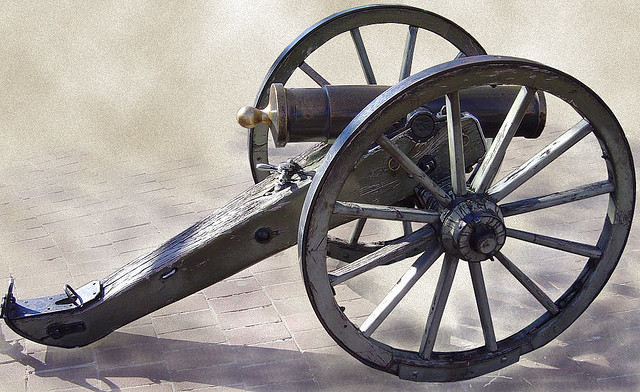
|
| 12-pounder Mountain Howitzer |
Although slightly differing models of the Mountain Howitzers were introduced
in 1835, 1838, and 1841, the effective range of the piece remained approximately 1000 yards. A veteran of the Mexican-American
War (1846-1848), several hundred of these diminutive tubes were produced by Union foundries during the Civil War (1861-1865),
and the Confederate Tredegar foundry produced approximately 21 additional pieces. A Federal battery of four proved "highly
effective" at the decisive battle of Glorieta, New Mexico, and Nathan Bedford Forrest frequently employed Mountain Howitzers
for "rapid close-in combat" that he preferred.
Model: 12-pounder Mountain Howitzer
Class: Field artillery, light
Type: Howitzer, smoothbore
Manufactured: 1835 to 1870
Tube Composition: Bronze
Bore Diameter: 4.62 inches
Powder Chamber: 3.3 inches
Standard Powder Charge: .5 lbs. Black Powder
Projectiles: 8.9 lb. round Shells or Case Shot
Effective Range (at 5°): approx. 1,000 yards
Tube Length: 38 inches
Bronze Tube Weight: 220 lbs.
Carriage Type: Pack Carriage or Prairie Carriage
No. in North America: approx. 400 to 500
Cost in 1861 Dollars: $165(US)
Notes: Nicknamed 'Bull Pups' by many gunners.
Model 24-pounder Howitzer
The 24-pounder Howitzer was a bronze smoothbore that complemented the 1841
US artillery arsenal. Being replaced by the modern Napoleon, the 24-pounder Howitzer was uncommon in Federal service
in 1862. Confederate artillery, lacking field pieces during the conflict, preserved the heavy and cumbersome 24-pounder
in its inventory. Known for its short range accuracy, the 24-pounder unleashed its 18.4 lb. projectile with
devastating effect. E. Porter Alexander, General Longstreet's Chief of Artillery for much of the war, called them "my
favorite guns."
| Civil War howitzer |
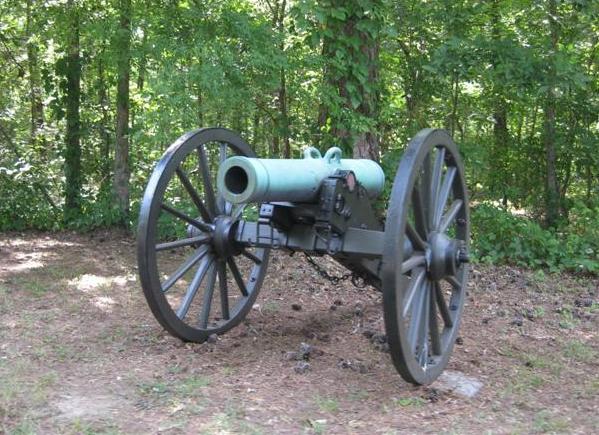
|
| 24-pounder Howitzer |
The howitzer was a short-barreled artillery piece designed to fire large
projectiles at high trajectories. Howitzers fired solid shot, spherical case, and canister. The 24-pounders used by the
Confederates at Gettysburg were of Austrian manufacture, and are easily distinguished by the twin "handles" on either side
of the tube.
When in defensive positions and field fortifications, 24-pounder Howitzers
were extremely effective pieces of ordnance because of their powerful 5.82 inch shells. Their 1400 pound weight, however, made
them a difficult to maneuver in the field, and their 1300 yard effective range put them at a disadvantage to other artillery
pieces. Nevertheless, infantrymen could not have relished the idea of charging a battery of 24-pdr howitzers.
Model: 24-pounder Howitzer
Type: Field artillery, heavy
Class: Howitzer, smoothbore
Manufactured: 1841 to 1863
Tube Composition: Bronze
Bore Diameter: 5.82 inches
Standard Powder Charge: 2 lbs.
Projectiles: 18.4 lb. spherical case, common shell, canister
Muzzle Velocity: 1,060 fps
Effective Range (at 5°): 1,322 yards
Tube Length: 65 inches
Tube Weight: 1,318 lbs.
Total Weight (Gun & Carriage): 2,443 lbs.
Carriage Type: No. 2 Field Carriage (1,125 lbs.), 57" wheels
Horses Required to Pull: 6
No. in North America: approx. 65
Notes: Companion to the 12 pdr. Field Gun & 12 pdr. Napoleon,
the Model 1841 24 pdr. Howitzer was the heaviest ordnance intended for use in the field.
Model 12-pounder Whitworth Breech-loading Rifle
The 12-pounder Whitworth, designed by Joseph Whitworth and manufactured
in England, was a rare gun employed during the Civil War. While the majority of field pieces were muzzle-loaders (loaded from
the front), the Whitworth was an interesting forerunner of present-day artillery because it was loaded from the
breech (the rear) and had exceptional accuracy over great distance. In 1864 it was stated that, "At 1600 yards the Whitworth
gun fired 10 shots with a lateral deviation of only 5 inches." Said degree of accuracy enabled the weapon to be
used effectively in counter-battery fire -- with the precision of the sharpshooter's rifle -- and for
distance firing over bodies of water. However, it was not popular as an anti-infantry weapon. It had a caliber of 2.75 inches
(70 mm), the bore was hexagonal in cross-section, and the projectile was a long bolt that twisted to conform to the rifling.
Records and reports indicated that the bolts made a very distinctive eerie sound when fired, which could be distinguished
from other projectiles.
Although the rifle was known for its great range and accuracy, it proved
difficult to remain in active service. First, ammunition was unique to the rifle, and expensive and difficult to import. Second,
the breechloading mechanism was prone to jam, forcing many guns to be loaded as a conventional muzzle-loader. Whitworths were
generally associated with the Confederacy, but there was one battery in Federal service in 1861. This battery only saw
field service during the Peninsula Campaign in 1862, and for the remainder of the war it augmented the existing defenses around
Washington, D.C.
| Civil War breechloading cannon |
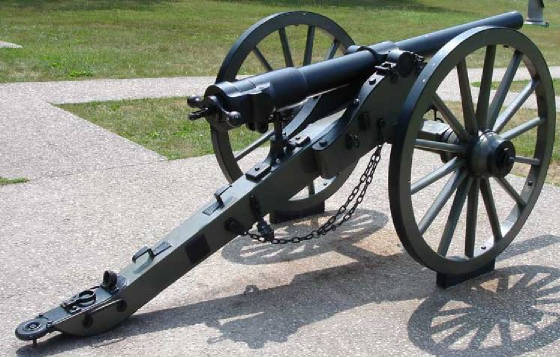
|
| 12-pounder Whitworth Breech-loading Rifle |
| Two Whitworth breechloading cannons at Gettysburg |
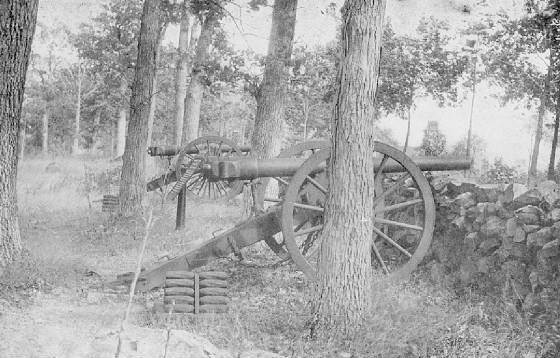
|
| English made 12-pounder Whitworth Breech-loading Cannons |
On August 10, 1861, Harper's Weekly described the gun:
"The Whitworth rifled cannon
obtains its remarkable power and accuracy by the adoption of a polygonal spiral bore of uniform pitch, more rapid than could
be obtained by grooves. The 12-pounder-one of which was a few days since exhibited in this city—with a bore of
3.2 inches, has one turn in sixty inches; it is eight feet long and breech-loading. The projectile is oblong, made of cast
iron, and formed to fit the grooves of the barrel. The breech of the gun is covered with a cap which screws on, and on being
removed swings to one side upon a hinge; the projectile is then inserted into the open breech, and followed by a tin cartridge-case
containing the powder, and capped by a cake of wax or other lubricating composition; the breech-cap is then swung to and screwed
on by its handles, a fuse inserted into the vent, and the gun is discharged. The lubricating matter being carried out with
the ball effectually cleanses the gun, and the deposit is afterward withdrawn with the cartridge-case. As there is no exhalation
of gases from the breech-cap, one of the worst features of breech-loading guns is avoided. The range of this gun is said to
be greater than the Armstrong gun, and its accuracy more positive. Guns of the size herein described cost £300 in England."
Model:
12-pounder Whitworth Breech-loading Rifle
Class: Field artillery, light
Type: Rifled-gun
Manufactured: England, 1861-1865
Tube Composition: Steel
Bore Diameter: 2.75 inches
Standard Powder Charge: 1.75 lbs.
Projectiles: 12 lb. hexagonal bolt
Tube Length: 104 inches
Tube Weight: 1,092 lbs.
Effective Range (at 5°): 2600 yards
Maximum Range (at 35°): 10,000 yards
No. in North America: approx. 50 (US & CS)
Invented By: Sir Joseph
Whitworth
Casting Foundry: Whitworth Ordnance Company, Manchester, England
Notes: Designed as breechloader, but muzzle-loading versions
of this weapon were produced.
Siege and Garrison Artillery
| Fox, William F. Regimental Losses |
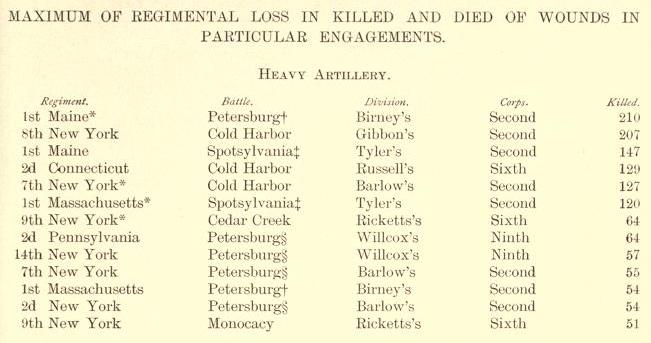
|
| Heavy Artillery regiments with most killed |
Siege and garrison artillery were heavy pieces that could be used either in attacking or defending
fortified positions, but the weight and size of siege artillery inhibited it from generally traveling with the army.
When required, siege artillery and other material needed for siege operations were assembled into what was known as a siege
train and transported to the field.
(Right) Fox, William F. Regimental Losses in the American Civil War (1889). Heavy Artillery regiments
with greatest losses in killed and mortally wounded during a single engagement. First Maine appears twice on the list,
along with the Seventh New York H.A. and Ninth New York. With the exception of Cedar Creek and Monocacy, all losses occurred during
the Overland Campaign (1864) and Siege of Petersburg (1864-65).
To meet the Union shortfall in the infantry ranks caused by attrition from three
years of bloody Civil War, many Union heavy artillery regiments were redesignated as provisional infantry regiments in 1864 and
rushed to the front lines during the Overland Campaign and into the trenches of Petersburg. While most heavy artillerists
had never fired a shot in battle, they were now confronted by determined veteran Confederate infantry in some of deadliest
battles of the war. From lines of battle at the Wilderness, Spotsylvania Court House, and Cold Harbor, to the nearly
10 month Siege of Petersburg it caused the heavy artillery units to sustain the majority, if not all, of their
casualties during the last year of the war. In only ten months, the First Maine Heavy Artillery Regiment, for example,
suffered more in killed or mortally wounded than any other Union regiment, including infantry, cavalry, and artillery,
during the entire four year Civil War. At the Battle of Spotsylvania Court House, VA., the First Maine lost 147
artillerists (turned infantry) in killed or mortally wounded and another 329 in wounded, only to suffer an additional 210
in killed the following month at Petersburg:
On June 18, 1864, 900 men of the First Maine Heavy Artillery Regiment, assigned as
provisional infantry, advanced across a cornfield when the Confederate line erupted in volleys of mortal fire at the
Mainers. Unsupported on their flanks, the Maine men were subjected to fire that seemingly hit from every angle. Within
a mere seven minutes, a staggering 210 men, including 13 officers, lay dead on the field, while 422 additional First
Mainers were wounded, and not a single man had come close to reaching the enemy line.
Although the regiment had advanced into battle, June 18, with 900 Mainers, it had lost 632 of Maine's finest in 420
seconds, or 3 men every two seconds. In the span of one month, from Spotsylvania to Petersburg, the First Maine
H.A. had been decimated with an unfathomable loss of 357 in killed or mortally wounded, and 751 of the unit's men
had been wounded. Grand Total Casualties: 1,108. See also Maine Civil War History.
Prior to May 1864, the First Maine had enjoyed, according
to many, comfy garrison duty at Washington. Inconceivably, this regiment had suffered all its losses in merely 10
months while deployed in the field as provisional infantry. The inexplicable casualties for the First Maine in those 10
months were as follows: 23 officers in killed or mortally wounded; 400 enlisted killed or mortally wounded; 260 died
of disease, as prisoners of war, and from all deaths other than battle. Grand Total Deaths: 683. Total Wounded: 860 (from
amputations to simple flesh wounds). Grand Total Casualties: 1,543. Many of the soldiers with flesh wounds continued
to muster, some being wounded a second and even third time, until hostilities ceased in 1865. The First Maine had
suffered the greatest loss of life for any regiment, infantry and cavalry included, during the four year conflict. In
addition, this H.A. unit suffered the greatest loss in killed during
a single engagement, 210, at Petersburg. The regiment, setting yet another Civil War record, had lost 23 of its
finest officers in the line of fire; more officers in killed than any other
Union regiment, including infantry and cavalry. See also Civil War Artillery Losses
| Siege guns and mortars were vital at Petersburg |
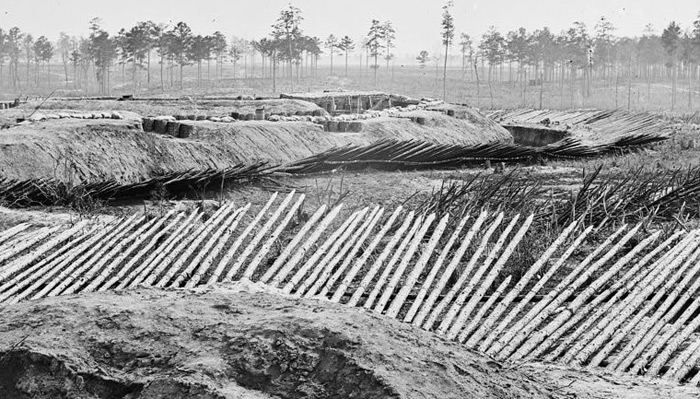
|
| Abatis in front of Federal trench lines at Petersburg in 1865 |
| Union siege line |
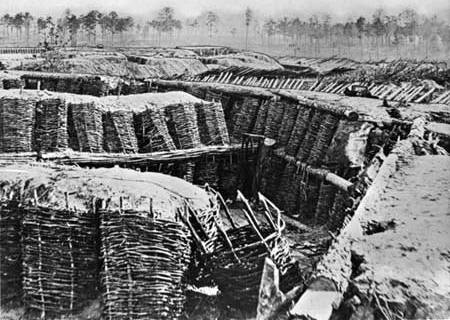
|
| A section of the Union siege line around Petersburg |
(Left) A section of the Union siege line around Petersburg. Note the use
of wickerware (gabions), sharpened stakes (fraises), and branches (abatis) to protect the lines. (Right)
Fort Sedgwick, Petersburg, VA., with trenches protected by abatis and fraises.
Prior to the war, the U.S. Army had a variety of iron smoothbore siege guns (12-, 18-, and 24-pounders)
and howitzers (24-pounder and 8-inch), but none of these pieces were used during the war as siege artillery. The advent of
rifled artillery made them obsolete.
Robert Parker Parrott developed a new form of rifled artillery using
a cast iron barrel with a reinforcing wrought iron band around the breech. He initially produced 2.9-inch (10-pounder)
and 3.67-inch (20-pounder) rifles for the field artillery, and later manufactured four larger rifled guns that were used as
siege artillery. These heavy Parrott rifles became the mainstays of the Federal siege train.
Robert Parker Parrott (October 5, 1804 – December 24, 1877) graduated
third in the Class of 1824 at the U.S. Military Academy at West Point; subsequently served as an instructor at West Point; in
1836 appointed superintendent of West Point Iron and Cannon Foundry in Cold Spring, New York; 1860 produced the Parrott rifle
gun, an innovative rifled cannon which was manufactured in several sizes. The largest, the 300-pounder version weighed 26,000
lb (11,800 kg), and its projectile weighed 300 lb (140 kg). Parrott guns remained in demand by both Union and Confederate
armies during the Civil War; 1867, Parrott ended his superintendency of the West Point Foundry to concentrate on the ironworks
in Orange County; continued to experiment with artillery shells and fuzes at West Point until his death at Cold Spring
at the age of 73.
The Civil War was the first major war to see the
use of rifled artillery. Rifling gave the guns greater velocity, range, accuracy and penetrating power, making smoothbore
siege guns obsolete. The ranges of these guns was somewhat problematic. The 6.4 inch (100-pounder) Parrott rifle, for example, had
a maximum range of 8,845 yards (5 mi; 8 km). Lacking suitable sights and an effective system of directing fire on targets beyond
line of sight (fire control system), targets that could not be viewed from the gun, inhibited the effective range of
the rifled guns.
| 300-pounder Parrott rifle on Morris Island, S.C. |
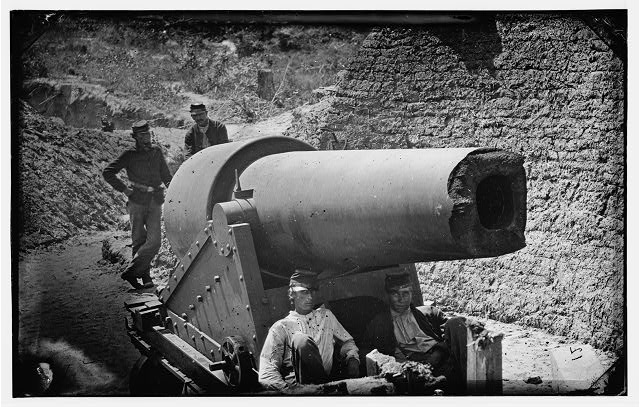
|
| Only three 10-inch (300-pounder) Parrotts saw service during the Civil War |
Principal Siege and Garrison guns with characteristics
|
Weapon |
Weight of projectile |
Weight of gun |
Range and Elevation (in yards) |
|
4.2 inch Parrott rifle
(30-pdr Parrott rifle) |
29 lb
(13 kg) shell |
4,200 lb. |
6,700 yd. @ 25° |
|
6.4-inch Parrott rifle
(100-pdr Parrott rifle) |
80 lb (36 kg) or 100 lb (45 kg) shell |
9,700 lb. |
8,845 yd. @ 35° |
|
8-inch Parrott rifle
(200-pdr Parrott rifle) |
200 lb
(91 kg) shell |
16,500 lb. |
8000 yd. @35° |
|
10-inch Parrott rifle
(300-pdr Parrott rifle) |
300 lb (140 kg) shell |
26,500 lb. |
--- |
(Right) The 300-pound solution on Morris Island, S.C., in 1863. A 10-inch
(300-pounder) Parrott rifle located at Battery Strong on Morris Island, S.C. The 10-inch Parrott rifle weighed 26,900 pounds
(12,200 kg) and was one of the largest rifled artillery pieces in use during the Civil War and it could fire
an explosive projectile that weighed 250 pounds at a distance of 9,000 yards (greater than 5 miles). This 10-inch Parrott
(standard length of 13 feet) lost eighteen inches off its muzzle when it fired its 27th round that prematurely exploded
inside the tube. Innovative Union troops managed to file the ragged edges down and kept this battery in action with little
ill effect. The gun fired another 371 rounds, without any appreciable difference in range or accuracy, before the "weapon
cracked and was declared useless." Although only three 300-pounder Parrotts were manufactured during the Civil War,
the powerful trinity were stationed on Morris Island, S.C., and engaged during the Campaign
against Charleston.
The most prominent siege and garrison gun on the battlefield belonged
to the Parrott Class.
Parrotts were manufactured with a combination of
cast and wrought iron. The cast iron made for an accurate gun, but was brittle enough to suffer fractures. Hence, a large
wrought iron reinforcing band was overlaid on the breech to give it additional strength. There were prior cannons designed
this way, but the method of securing this band was the innovation that allowed the Parrott to overcome the deficiencies of
these earlier models. It was applied to the gun red-hot and then the gun was turned while pouring water down the muzzle, allowing
the band to attach uniformly. By the end of the Civil War, both sides were using this type of gun extensively.
Parrott rifles were manufactured in different sizes, from 10-pounders up
to the rare 300-pounder. In the field, the 10- and 20-pounders were used by both armies. The 20-pounder was the largest field
gun used during the war, with the barrel alone weighing over 1,800 pounds. The smaller size was much more prevalent; it came
in two bore sizes: 2.9 inch (74 mm)and 3.0-in (76 mm). Confederate forces used both bore sizes during the war, which added
to the complication of supplying the appropriate ammunition to its batteries. Until 1864, Union batteries used only the 2.9-in.
The M1863, with a 3-in bore, had firing characteristics similar to the earlier model; it can be recognized by its straight
barrel, without muzzle-swell. Its range was up to 2,000 yards (1,800 m) with a trained crew.
Versions of the 20-, 30-, 60-, and 100-pound Parrotts were also used by
the Union Navy. The 100-pound naval Parrott could achieve a range of 6900 yards (6300 meters) at an elevation of 25 degrees,
or fire an 80-pound shell 7810 yards (7140 m) at 30 degrees elevation.
Although accurate, as well as less costly and easier to produce than
most rifled artillery guns, the Parrott had a poor reputation for safety and they were shunned by many artillerists.
At the end of 1862 some sought to eliminate the Parrott altogether, preferring the 3-inch Ordnance rifle. During battles
when the Parrott gun would burst, artillerists would chip out the jagged parts and continue firing.
Model 30-pounder Parrott Rifle
| 30-pounder Parrott rifle |
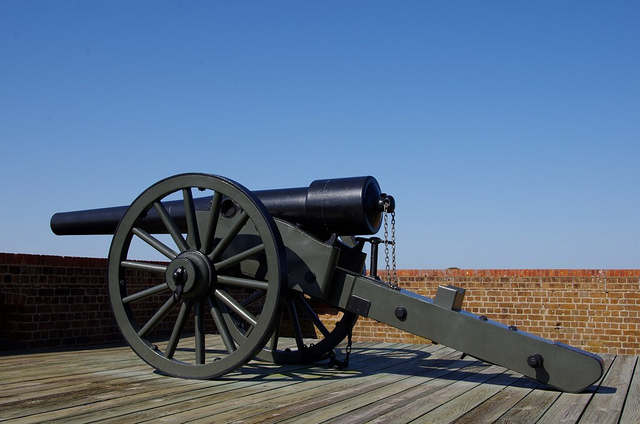
|
| Classified as Siege and Garrison, but 30-pounder Parrotts were occasionally used as Field artillery |
| 30-pounder Parrott guns near Charleston, S.C. |
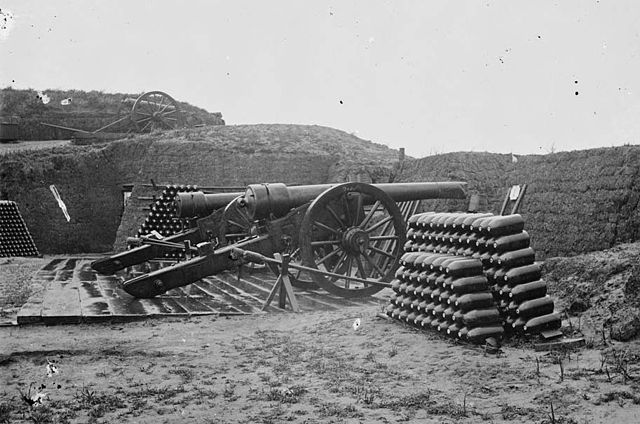
|
| Two 4.2-inch (30-pounder) Parrott rifles and stacks of shells inside Fort Putnam on Morris Island |
(Left) Two 4.2-inch (30-pounder) Parrott rifles and stacks of shells inside
Fort Putnam on Morris Island, South Carolina, during the Campaign against Charleston Harbor. Classified as siege and
garrison, the daunting but sluggish 3.25 ton 30-pounder was occasionally transported by 10 horses, as it eked across
the countryside, and employed as impressive field artillery. (Right) 30-pounder Parrott Rifle at Fort Pulaski National
Monument.
4.2-inch (30-pounder) Parrott rifle. The 4.2-inch (30-pounder) rifles were
the most widely used of the Parrott siege guns. It was mounted on a conventional siege carriage. The early pattern guns had
the elevating screw under the breech, while newer pattern gun had a long screw running through the cascabel. The long elevating
screws of the newer models was subject to breaking. The 4.2-inch Parrott rifles were preferred over the 4.5-inch siege rifles
because of the superiority of Parrott shells over the various shells available for the 4.5-inch siege rifle. The 4.2-inch
Parrott rifles did not have the same problems with bursting that were with found with the larger Parrott rifles. During the
siege of Petersburg 44 4.2-inch Parrott rifles fired 12,209 rounds. Only one gun burst when a shell detonated before clearing
the muzzle. One 4.2-inch Parrott rifle also burst during the Campaign against Charleston Harbor, but only after it had fired
4,606 rounds.
Model: 30-pounder Parrott
Rifle
Class: Siege and Garrison (common); Field, heavy (rare)
Type: Rifled-gun
Manufactured: USA and CSA; 1861 to 1866
Tube Composition: Cast Iron, Wrought Iron Breech Band
Bore Diameter: 4.2 inches
Rifling Type: 5 grooves, 1.3 inches wide, right hand gain twist
Standard Powder Charge: 3.25 lbs. Black Powder
Projectiles: 24 lb. Bolts, 24 to 29 lb. Shells
Range (at 15°): 4,800 yards (2.7 miles)
Max Range (at 35°): 8,453 yards (4.8 miles)
Tube Length: 131.5 inches
Tube Weight: 4,200 lbs. (2.1 tons)
Total Weight (Gun & Carriage): 6,500 lbs. (3.25 tons)
Carriage Type: No. 2 Siege Carriage (2,300 lbs.)
Horses Required to Pull: 10
No. in North America: 391
Invented By: Robert
Parker Parrott in 1861
US Casting Foundry: West
Point Foundry, Cold Spring, NY
CS Casting Foundry: Tredegar
Iron Works, Richmond, VA
Model 100-pounder Parrott Rifle
| 100-pounder Parrotts |
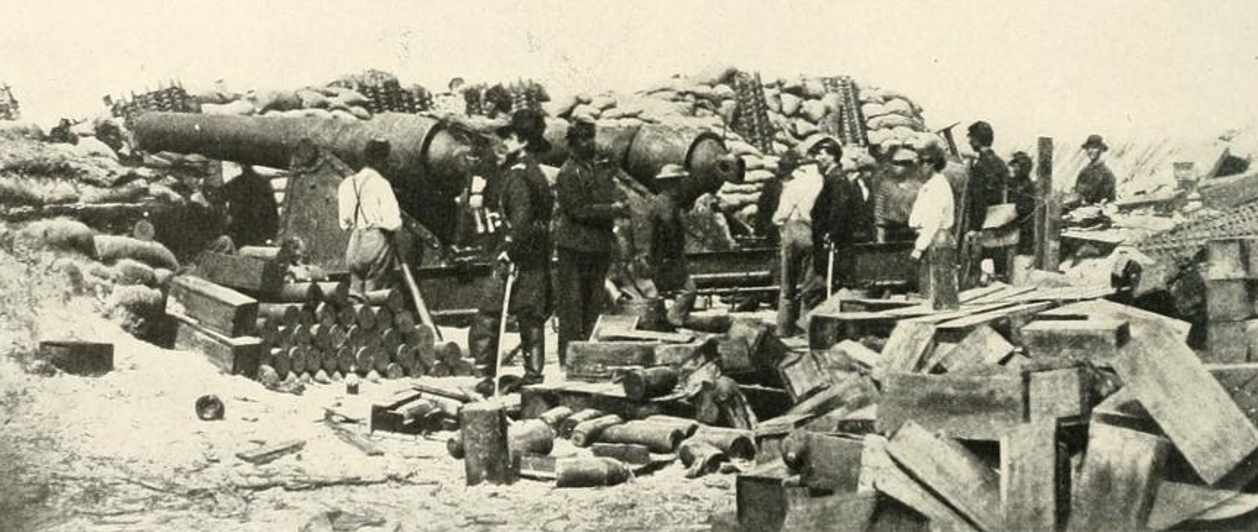
|
| 100 pounder Parrott rifles at Union Battery Rosecrans are trained upon Battery Wagner in 1863 |
The 6.4-inch (100-pounder) Parrott rifle was a dominant siege
gun capable of great accuracy and long range with heavy projectiles. For use as a siege gun, it was mounted on a front pintle
barbette carriage. The 100-pounder Parrott had a maximum range of 3100 yards at 9 degrees elevation, usually fired bolt
(solid shot) and shell projectiles, with case shot as an option. Fuze and projectile inventor Andrew Hotchkiss supplied
bolts and shells for the 6.4-inch Parrott rifles, while John P. Schenkl provided bolts and shells, along with case
shot projectiles. The heavy rifle did, however, tend to burst. Of the three hundred plus 6.4-inch Parrott riles in service
with the U.S. Navy, 19 burst. A total of 585 (233 Army; 352 Navy) massive 100-pounder Parrotts were manufactured
exclusively at West Point Foundry. The Union Army relied on this piece for the duration of the conflict because of its
outstanding performance. During the Campaign against Charleston Harbor, nevertheless, one burst at salvo number
122 and another burst after firing 1,151 rounds. The army was not deterred, and its commitment and enthusiasm for the heavy
gun was voiced on many occasions. General Quincy A. Gilmore, commander of the Federal forces at Charleston, said “[t]here
is, perhaps, no better system of rifled cannon than Parrotts; certainly none more simple in construction, more easily understood,
or that can with more safety be placed in the hands of inexperienced men for use.” The 100-pounders were deployed against
numerous siege targets, including: Yorktown, Virginia; Fort Sumter and Battery Wagner, South Carolina; and Richmond
and Petersburg, VA. Although the Washington, D.C., area had 68 major enclosed forts, as well as 93 prepared (but unarmed)
batteries for field guns, during the Civil War, few guns were fired in anger. The 6.4
inch Parrotts were employed in the defenses of Washington, and salvos were fired in July 1864 during Gen. Jubal Early's
advance on the capitol. Fort DeRussy, one of the numerous fortifications protecting Washington, fired its impressive 100-pounder 28
times to deter the 12-15,000 advancing Confederates. Although Early refused to advance within close proximity of Washington
for a myriad of reasons, the 100-pounders should be included in the equation. By 1865, the formidable 100-pounder Parrott
had been deployed to every major theater of the conflict.
| Defenses of Washington, DC |
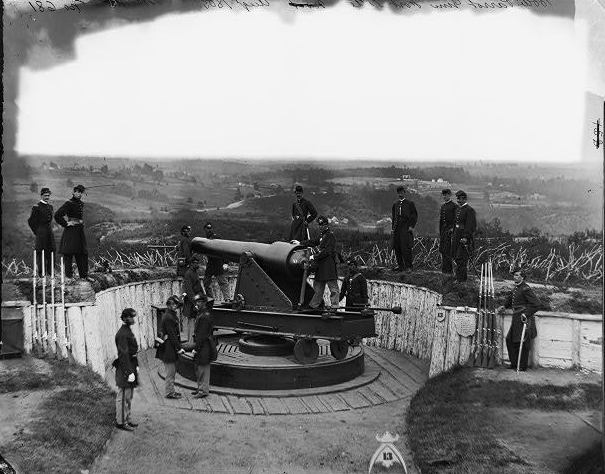
|
| 3d Mass. Heavy Artillery and 100-pdr. Parrott gun on iron barbette carriage at Fort Totten |
| Mixed Artillery Battery during Siege of Petersburg |
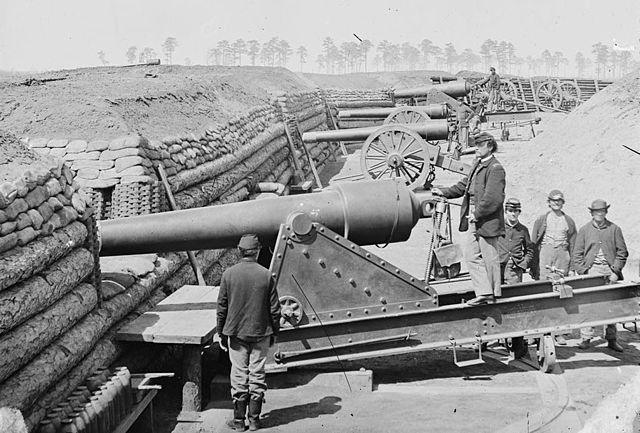
|
| 100-pounder Parrott rifles on each flank at Fort Brady, Petersburg, VA. |
(Left) Fort Brady, near Petersburg, VA, Battery of Parrott guns
manned by Company C, 1st Connecticut Heavy Artillery in 1865. Two 6.4-inch 100-pounder Parrott rifles, on the flanks,
and two 4.2-inch 30-pounder Parrotts, center on siege carriages, inside Fort Brady during the Siege of
Petersburg in 1865. The 6.4-inch rifles are on iron, front pintle, barbette carriages and the 4.2-inch rifles are on siege
carriages. During the Battle of Trent's Reach, Confederate gunners across the river disabled the enormous 100-pounder Parrott
rifle seen in the foreground. Union photographers Andrew J. Russell and T.C. Roche arrived south of Richmond in 1865 and recorded
some of the most important images of Fort Brady. This view was taken from the parapet
and depicts the fort's fighting battery. In the six months of Fort Brady's wartime existence, these guns fired 1,356 rounds.
(Right) Defenses of Washington. Washington, D.C. (known as Washington City at the time), and officers of Companies A and B,
3rd Massachusetts Heavy Artillery, and crew of 100-pdr. Parrott gun on iron barbette carriage at Fort Totten.
Model 200-pounder Parrott Rifle
The 8-inch (200-pounder) Parrott
rifle was essentially an enlarged 6.4-inch Parrott rifle with similar qualities. One of the most famous 8-inch Parrott
rifles was the “Swamp Angel” used for the bombardment of the city of Charleston in 1863, but it burst during its 36th discharge.
The Union Army rated the 200-pounder based on the weight of the
long projectile preferred for land use, while the Union Navy preferred a shorter, lighter projectile to achieve higher velocities
at short range. Hence the different “pounder” designation. The 8-inch Parrott's tube alone was more
than two and a half tons heavier than the smaller 6.4-inch tube. West Point Foundry produced 91 of the 8-inch Parrotts
for the army and 87 for the navy between March 1862 and July 1865. Similar to the 6.4-inch Parrotts, the army deployed
the 8-inch rifles in seacoast forts and for siege operations, particularly around Charleston. The navy, however, used
the 8-inch Parrotts on pivot mounts and in monitor turrets.
Both the 6.4-inch Parrott and the heavier 8-inch model's solid
bolt projectiles were designed with warships and fortifications as primary targets. For anti-ship use, the navy preferred
a lighter bolt than the army. Although navy ordinance officers focused on Confederate ironclad targets, typically such
engagements were close range affairs. Navy instructions called for the use of light weight bolt with “chilled”
noses. Said projectiles accelerated rapidly maximizing penetration under 1000 yards, but at the sacrifice of accuracy
and effectiveness at longer ranges. The shot for the navy’s 8-inch Parrotts weighed between 125 and 150 pounds and was between
12 and 14 inches long.
But the army, however, preferred to engage enemy ironclads at greater
ranges, and heavier bolts offered better accuracy and penetrating force at those ranges. Army bolts weighed 200 pounds
and were approximately 17 inches in length. The 200-pounder Parrotts also used “long” and “short”
Parrott shells, but the service distinction appears less explicit. The navy used anything available at several points
in the war, particularly during the 1864 bombardment of Fort Fisher, North Carolina. But perhaps the most famous of the
8-inch shells were those hurled by the “Swamp Angel” into Charleston, South Carolina in 1863.
Other Parrott shells fired into Charleston included incendiary rounds. West
Point Foundry produced 500 of these in 1863, in both single and double cavity shells. A hexagonal-headed bolt in the
base of the shell covered an opening into which the incendiary mixture was loaded. Besides Parrott shells, the army used Schenkl
shells in the Charleston area. Due to concerns about Parrott projectile performance, the navy ordered mass quantities
of Schenkl 8-inch projectiles. The projectiles and carriages allowed the 8-inch Parrotts to batter enemy ships as well as
fortifications.
| 200-pounder Parrott gun in 1865 |
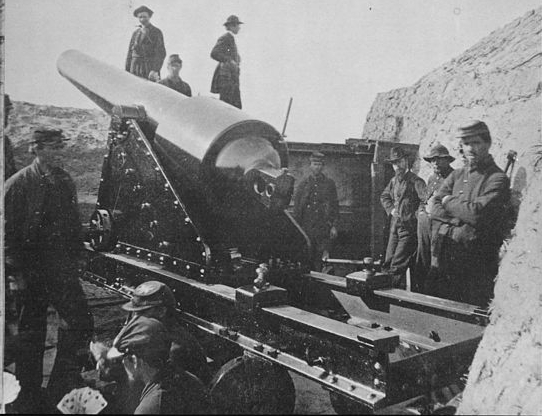
|
| A 200-pound Parrott rifle in Fort Gregg on Morris Island, South Carolina |
| 300-pounder Parrott was the largest Parrott gun |
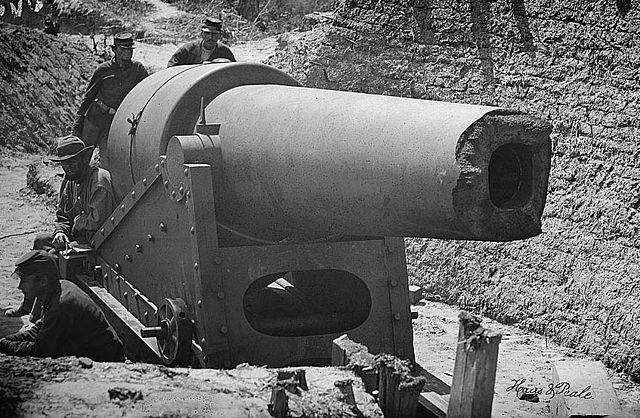
|
| Morris Island, South Carolina. 300-pounder Parrott Rifle after bursting of muzzle in 1863 |
The famous 200-pounder Parrott rifle known as the "Swamp Angel" was used
by Brig. Gen. Quincy Adams Gillmore to bombard Charleston. It was manned by the 11th Maine Volunteer Infantry Regiment.
On August 21, 1863, Gillmore sent Confederate general P. G. T. Beauregard an ultimatum to abandon heavily fortified positions
at Morris Island or the city of Charleston would be shelled. When the positions were
not evacuated within a few hours, Gillmore ordered the Parrott rifle to fire on the city. Between
August 22 and August 23, the "Swamp Angel" fired on the city 36 times (the gun burst on the 36th round and wounded 4 of its
crew), using many incendiary shells which caused little damage and few casualties. Although the weapon caused negligible damage
to the city itself, it did, however, terrorize its populace.
The indiscriminate shelling of Charleston has been justified by many historians. Some have stated that Charleston
was a center for munitions manufacturing, while others proclaimed that the city was the seat of the rebellion. With accurate
firing, which the 200-pounder appreciated, perhaps the initial statement can be justified, but the latter claim for bombing
Charleston indiscriminately definitively goes to motive. Another historian wrote that under the "existing rules
of warfare, Charleston was a legitimate target. It was an armed camp." Sherman also justified the indiscriminate targeting
of cities and homes during the Civil War by stating that Southern cities collectively assisted the Confederate Army
and prolonged the war. Sherman stated in a letter to the City Council of Georgia on September 12, 1864, that "You cannot
qualify war in harsher terms than I will. War is cruelty, and you cannot refine it; and those who brought war into our country
deserve all the curses and maledictions a people can pour out." Sherman also boasted that "I will make Georgia howl!"
| 200-pounder Parrott rifle, aka Swamp Angel |
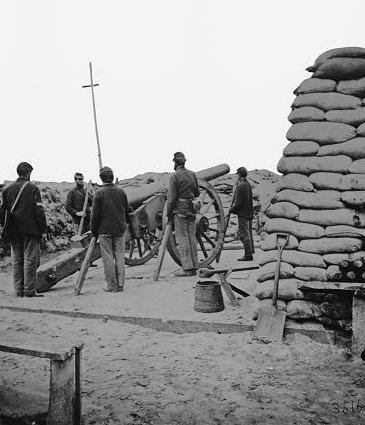
|
| Union Swamp Angel on Morris Island, SC, in 1863 |
Sherman made his motive clear, I will make Georgia howl. Georgia, at that
time, consisted primarily of civilians: from babies, women, disabled, and the elderly. Georgia had lost most of her abled-bodied
men to the fighting some three years before Sherman staked his position. In 1864, when Sherman made many of his statements,
the majority of Georgia's fit men were in other states fighting in pitched battles and in trench warfare. But where there
was an action, there was a motive. Sherman was therefore known as the general who employed "total war."
The motive for shelling Charleston indiscriminately
with the behemoth, the "Swamp Angel," was stated explicitly by Gillmore himself: "I expected no battlefield
victory from the shelling, but felt that valuable artillery techniques were learned."
Nevertheless, many civilians had already left Charleston before the campaign
had begun and those who remained merely relocated from the city's lower regions to areas out of range of the Federal guns.
The city's manufacturing and industrial work continued, and all maritime activity was shifted up river. While the so-called
"Swamp Angel" entertained Union soldiers and the majority of the Northern press, it also unleashed a disgust
from some Northerners who believed that firing on helpless, unarmed civilians was an atrocity not approved
by any civilized society, but perpetrated by some who desired revenge on a people nesting in the hotbed of the rebellion. In
a message to Gillmore, Gen. Beauregard, commanding forces in Charleston, condemned the indiscriminate bombardment of
the city and threatened retaliation. Foreign consuls equally leveled charges against the Union action.
Model 300-pounder Parrott Rifle
10-inch (300-pounder) Parrott rifle. The largest of the Parrott Class, only
three 10-inch (300-pounder) Parrotts saw service during the war. The three 300-pounders were stationed on Morris Island
during the Campaign against Charleston Harbor, and were mounted on a center pintle, barbette carriage. The 100, 200, and 300-pound
Parrotts were basically different sizes of the exact rifle, but artillerists had preferences. The 10-inch Parrott was
considered an enlarged 8-inch Parrott rifle, although the 300-pounder was believed to be more accurate than the 8-inch
rifle. Like the other large Parrotts, the 10-inch fired solid bolts, shells, and case shot. One 10-inch Parrott rifle on Morris
Island was disabled after the premature detonation of a shell, which destroyed 18 inches of its muzzle. The damaged
end of the muzzle was trimmed even by soldiers working with cold chisels, and the gun fired an additional 370 salvos without
any appreciable difference in range or accuracy. The gun was subsequently permanently disabled with the premature
detonation of another shell.
By summer 1863, Union forces became frustrated by the heavily fortified
Confederate position at Fort Sumter, and brought to bear the 10-inch (250 mm) Parrott, along with several smaller cannons.
Fort Sumter was on the receiving end of salvos from two 80-pounder Whitworths, nine 100-pounder Parrotts, six 200-pounder
Parrotts, and one 300-pounder Parrott. It was widely believed in the North that the massive 10-inch Parrott would finally
break the previously impenetrable walls of the fort, which had become the symbol of stalwart steadfastness for the Confederacy,
but the cannon failed. As Sumter crumbled, it closely resembled a concrete earthwork that was impervious to artillery fire.
Characteristics: Model 10-inch (300-lb) Parrott rifle; origin
United States; class heavy / siege; type rifled-gun; inventor Robert Parker Parrott; manufacturer West Point Foundry,
Cold Springs, New York; total production 3; length 13 feet (3.9264 meters); weight 26,900 pounds (13.45 tons; 12,201.6 kg);
projectile 300-lb (136 kg); charge 26-lb (11.793 kg); maximum range and elevation 9,000 yards (greater than 5 miles; 8.2296
kilometers) at 30 degrees; flight time 202.5 seconds estimated.
While only three 10-inch (300-pounder) Parrotts engaged during the conflict, all
three were located on Morris Island during the Campaign against Charleston Harbor. The 300-pounder was one of the largest
guns in service during the war. The largest gun, however, was the colossal 115,200 pound 1864 20-inch
Rodman cannon, more commonly known as the 20-inch Rodman gun, but the behemoth never fired a shot in anger, only 8 practice
rounds.
Principal characteristics of Siege and Garrison Artillery
| Seige and Garrison Artillery |
Artillery
Piece |
Bore
diameter
(inches) |
Material |
Length
of tube
(inches) |
Weight
of tube
(pounds) |
Weight of
projectile
(pounds) |
Weight of
charge
(pounds) |
Range at 5°
elevation
(yards) |
| 4 1/2-inch Rifle |
4.50 |
Iron |
133.0 |
3,450 |
33.0 |
3.50 |
2,078 |
| 30-pdr Parrott Rifle |
4.50 |
Iron |
136.00 |
4,200 |
1 29.0 |
3.75 |
2,200 |
| 24-pdr Gun |
5.82 |
Iron |
124.00 |
6,240 |
24.4 |
6.00 |
1,901 |
| 18-pdr Gun |
5.30 |
Iron |
123.25 |
4,680 |
18.5 |
4.50 |
1,592 |
| 12-pdr Gun |
4.62 |
Iron |
116.00 |
3,120 |
12.3 |
4.00 |
1,834 |
| 8-inch Howitzer |
8.00 |
Iron |
61.50 |
2,614 |
1 50.5 |
4.00 |
1,241 |
| 8-inch Mortar |
8.00 |
Iron |
22.50 |
930 |
1 44.5 |
3.75 |
2 1,200 |
| 10-inch Mortar |
10.00 |
Iron |
28.00 |
1,852 |
1 87.5 |
4.00 |
2 2,100 |
| 24-pdr Coehorn Mortar |
5.82 |
Bronze |
16.32 |
164 |
1 17.0 |
0.50 |
2,4 1,200 |
1. Weight of shell.
2. Mortar ranges are given at an elevation
of 45°.
3. Bore length only.
4. Designed to be moved and operated by three men.
5. Obtained ranges greater than 4,812
yards with shell and 27° elevation.
6. Obtained ranges greater than 5,600 yards with shell and 39° elevation.
7. Obtained
ranges of 4,680 yards with a 315-lb. shell and 50 lbs. powder at 25°.
8. Extreme range of 8,428 yards.
9. Muzzle-loading
Armstrongs had practically identical dimensions and ranges.
Model 4.5-inch Siege Rifle
The 4.5-inch Siege rifle looks like a larger version of the 3-inch ordnance
rifle and it is often called a 4.5-ordnance rifle. However, the 4.5-inch Siege rifle was of conventional cast iron construction
and did not use the welded wrought iron construction of the 3-inch Ordnance rifle. The 4.5-inch Siege rifle fired shells weighing
about 30 pounds (depending on the specific type of shell). It weighed 3,450 pounds and was 133 inches long. The gun’s
only flaw was that it suffered from excessive erosion of the vent caused by the hot gasses flowing through the vent when the
gun was fired. The vent could be too large to fire the gun after 400 discharges. This problem could be remedied by insertion
of a copper vent piece.
| 4.5 inch Siege Rifle |
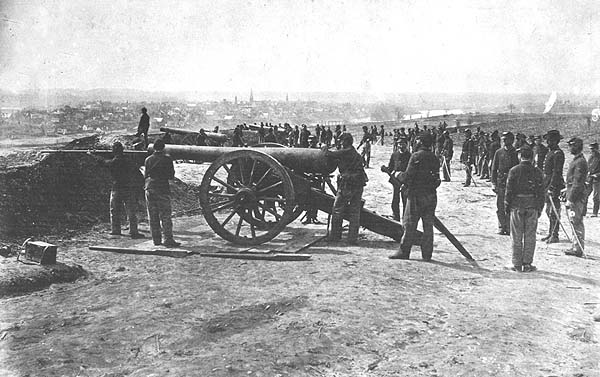
|
| 4.5 inch Siege Rifle was known for its superior range, accuracy, and mobility |
In addition to its use as siege artillery, two batteries of 4.5- siege rifles
(8 guns total) accompanied the Army of the Potomac as “heavy” field artillery between 1862 and 1864. The big guns
were intended for long range firing against Confederate artillery. Although the guns showed very good mobility, they saw little
action.
Model: 4.5 inch Siege Rifle
Class: Siege and Garrison (common); Field, heavy (common)
Type: Rifled
Manufacture: USA, 1861-1866
Tube Composition: Cast Iron
Bore Diameter: 4.5 inches
Rifling Type: 9 rifle grooves
Standard Powder Charge: 3.25 lbs.
Projectiles: 30 lbs. Hotchkiss or Schenkl Shells
Effective Range (at 10°): 3,265 yards
Tube Length: 133 inches
Tube Weight: 3,450 lbs.
Total Weight (Gun & Carriage): 5,750 lbs. (2.8 tons)
Carriage Type: No. 2 Siege Carriage (2,300 lbs.)
Horses Required to Pull: 8
No. in North America: 113
US Casting Foundries: Fort Pitt Foundary, PA
Notes: More reliable than the 20 pdr. Parrott Rifle and 800
lbs. lighter than the 30 pdr. Parrott Rifle
Siege and Seacoast Mortars
Mortars were short, smoothbore cannon designed to throw large, hollow projectiles
at high elevations with a small charge of powder: Civil War-era mortars were generally used in coastal defense forts, aboard
mortar boats, and during siege operations. Mortars were classed as "siege" or "seacoast" guns. The 8-inch and 10-inch mortar
siege guns, while cumbersome, could be transported on mortar wagons. The longer and heavier seacoast models of the
10-inch and the colossal 13-inch mortars were classified as "seacoast," as they could only be transported with
great difficulty by rail or ship.
Seacoast artillery made rapid technological advances from the 1840s through
the Civil War. The 32- and 42-pounder seacoast guns (with the James System), 8- and 10-seacoast mortars, were a product of
1841--all excellent weapons for the era. Yet these weapons were soon superseded by a number of much more sophisticated heavy
weapons that saw far-reaching impact on future artillery trends. The most significant progress made during the period occurred
in the development of heavy-caliber, long range shell guns.
| Civil War siege and seacoast mortars |
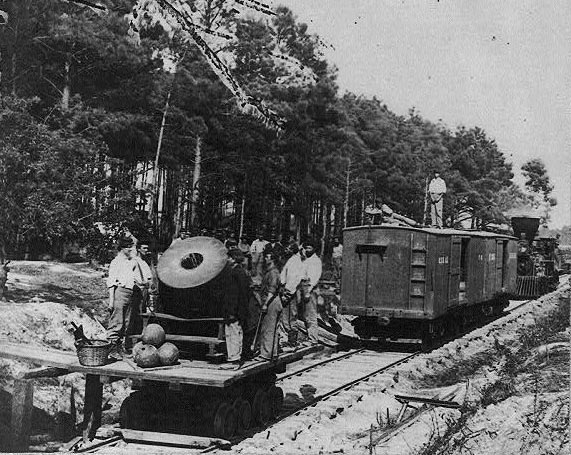
|
| 13-inch seacoast mortar, Model 1861, "The Dictator" on railroad cars during the siege of Petersburg. |
Three primary types of mortars were used during the war: siege and
garrison (light), seacoast (heavy), and Coehorns were also classified as siege and garrison. While guns were intended
to batter down the walls of a fortification during a siege, mortars were designed to fire explosive shells over the walls
of the fortification, killing garrison personnel, forcing the garrison to stay in bombproof shelters, and preventing the garrison
from serving their guns and repairing damage caused by the bombardment. Mortars could destroy structures inside the fortification
such as barracks and kitchens, and, during siege operations, could accurately penetrate trenches killing personnel.
With precision, mortars could also destroy targets that were accustomed to the safety provided by defilade, and
heavier mortar shells could penetrate magazines and bombproof shelters.
In defense of fortifications, siege and garrison mortars could harass work
parties constructing siege batteries and trenches. They could also be used for fire suppression, known as counter-battery
fire, against siege batteries. Seacoast mortars could penetrate the decks of wooden ships and even threaten the deck
plating of ironclad vessels.
The 8-inch and 10-inch siege mortars had a maximum ranges of 2,225 and 2,064
yards, respectively, and the 13-inch seacoast mortar had a maximum range of 4,300 yards, but their effective ranges were much
shorter. For the 8-inch siege mortar at a range of 800 yards, nearly 50% of the shells would fall within a 50-yard radius
of the target. With the 10-inch siege mortars at 875 yards, approximately 60% of the shells would fall within a 40-yard radius
of the target. The 13-inch seacoast mortar could be expected to be more accurate. Coehorn mortars were lighter mortars, designed
to be brought well forward in the trenches. With the replacement of masonry fortifications with earthen works, mortars became
more important. Works that could resist the horizontal fire of guns were still vulnerable to the vertical fire of mortars.
The principal siege and seacoast mortars widely used when the Civil
War commenced
|
Weapon |
Weight of shell |
Weight of mortar |
Weight of bed |
|
Model 1841 Coehorn mortar (5.82-inch) |
17 lb. |
164 lb. |
132 lb. |
|
Model 1841 8-inch siege mortar |
44 lb. |
930 lb. |
920 lb. |
|
Model 1841 10-inch siege mortar |
88 lb. |
1,852 lb. |
1,830 lb. |
|
Model 1841 10-inch seacoast mortar |
88 lb. |
5,775 lb. |
--- |
|
Model 1861 13-inch seacoast mortar |
197 lb. |
17,120 lb. |
--- |
Model 1841 24-pounder Coehorn Mortar

Patterned after earlier models developed by Baron Menno Van Coehorn in 1692,
the 1841 24-pounder Coehorn fired an explosive 24 pound projectile, known as a bomb. Initially used during the Mexican-American
War (1846-1848), the weapon was employed by both Union and Confederate forces during siege operations. Because of the shortage
of bronze in the South, however, iron was the substitute.
The Coehorn mortar, a small muzzle-loading mortar that principally fired
shells, was mounted on a block or platform and was mobile as well as effective in sieges. The Union Army had the
brass 24-pounder Coehorn that weighed 164 pounds, or 296 pounds when mounted on it's four-handled oak mortar bed. Although
two men could move this mortar, it was maneuvered quickly into position with a four
man crew. The Union Artillery manual, however, indicated the nominal crew was three – a gunner and two cannoneers.
Explosive shells could be lobbed
into masked and obstructed targets from 25 to 1,200 yards with the Coehorn. Although
the Model 1841 24 pdr. Coehorn was the most widely used by the Union military, the Confederate army did employ
the iron cast 12-pounder version, with a bore of 4.62 inches, as well larger
iron 24-pdrs. As the war progressed, trench warfare became prevalent, and mortars were increasingly deployed. With a one-half
ounce charge and at 45 degrees, the 24-pounder Coehorn could fire and hammer close targets of 25 yards. The eight-ounce
charge at said trajectory, however, would strike the enemy at a distance of 1,200 yards. The 12-pounder Coehorn, meanwhile,
was classified as light and, being highly mobile, was used generally in siege operations.
| Broadway Landing, Appomattox River, Virginia. |
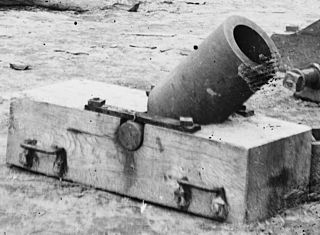
|
| Confederate iron 24-pounder Coehorn mortar in 1865 |
Model: 24-pounder 1841 Coehorn
Mortar
Class: Siege
Type: Mortar, smoothbore
Manufactured: 1841-1865
Tube Composition: Bronze (Majority of C.S. variants were cast in iron)
Bore Diameter: 5.82 inches
Standard Powder Charge: 1/2 lbs.
Projectiles: 16.8 lbs. Round Mortar Shells
Tube Length: 16.3 inches
Tube Weight: 164 lbs.
Overall Weight: 296 lbs.
Range (at 45°): 1,200 yards
No. in North America: 279
Invented By: Dutch inventor, Baron van Menno Coehoorn
Notes: Inexpensive mortar that was widely employed by
both Union and Confederate forces. Capable of destroying obstructed targets with its high angle trajectory.
Model 8-inch Siege Mortar
| Broadway Landing, Richmond, VA., 1865 |
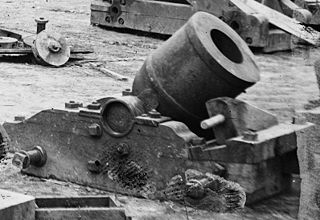
|
| Model 1841 8-inch siege mortar |
The 8-inch Siege Mortar was classified as light and, being highly mobile,
engaged in both siege and sea operations. Naval or sea mortars, were fired from ships against enemy defenses, and from
sea as counter-battery fire against fortifications. Although the nomenclature "siege" designates the mortar's classification,
the versatile 8-inch mortar, however, was employed from field, seacoast, siege and garrison, to mortar boats.
According to U.S. ordnance manuals, seacoast mortars belonged to the "heavy"
class, and were procured to defend the coastline, harbors, ports, and cities by applying high angle fire against enemy
ships. General trajectory was 45 degrees for all mortars, but due to the exigencies of war, seacoast and the siege and garrison
mortars were often times interchanged, as was demonstrated with the colossal 13-inch seacoast mortar.
Unlike guns and howitzers that relied on line of sight firing, mortars calculated
weight of both projectile and powder charge, fuze type, and distance to target to acquire target positioning. Distance
and timing were also critical factors for effective mortar fire, because a target at 4,500 yards required approximately 30
seconds of flight time (important when firing on ships). On the receiving end of mortar projectiles, many soldiers stated
that the difference in sound distinguished the mortar from other artillery weapons. Although mortar fire was not too accurate,
due to the lack of line of sight capability, the crew quickly performed firing adjustments since most of their targets,
such as trenches and fortifications, were obviously stationary.
In 1839, with U.S. modernization of its artillery arsenal, the Ordnance
Board sought to add to its arsenal the pattern of 8- and 10-inch siege mortars. Subsequently, contracts were secured in 1841
for both sizes. The U.S. Army was satisfied with the overall performance of the mortars during the Mexican War, and, with
further upgrading required to protect the nation's coast, manufacturing of larger seacoast mortars followed. The 8-inch
mortars were designated as siege mortars, and the 10-inch models were procured with both siege and seacoast designations,
and the massive Model 1861 13-inch Seacoast Mortar was assigned primarily to seacoast duty, and was classified by the Army
as seacoast for locations such as fortifications and coastal defenses, and classified as Navy or sea while aboard warships.
In 1841 the U.S. Army procured a total of 41 Model 1841 8-inch Mortars,
and in 1861, a slightly modified version was manufactured. The Model 1861 8-inch Mortar had a slightly longer bore, allowing
a modest improvement on firing distances, and a total of 170 were produced. Differences between 1841 and 1861 models included
slight increases: bore length from 15 to 16 inches, weight from 925 to 1,010 lbs., 1.6 lb. to the 2 lb. charge, retained its
earlier 46 lb. shell, range increased from 1,200 to 1,275 yards.
Model 10-inch Mortar
| Artillery Piece |
Overall Length (inches) |
Weight (pounds) |
Weight of Loaded Shell (lbs.) |
Powder Charge (pounds) |
Range (yards) |
Total Produced |
Manufacturers |
|
Model 1841 10-inch
Siege Mortar |
28 |
1,800 |
98 |
4 |
2,100 |
98 |
Alger, Fort Pitt, West Point |
|
Model 1841 10-inch
Seacoast Mortar |
46 |
5,775 |
98 |
10 |
4,250 |
33 |
Alger, West Point |
|
Model 1861 10-inch Siege Mortar |
29.25 |
1,900 |
98 |
4 |
2,235 |
150 |
Alger, Fort Pitt, S-McM |
|
Model 1861 10-inch Seacoast Mortar |
49.25 |
7,300 |
98 |
12 |
4,536 |
8 |
Alger |
| Union Seacoast Mortars, aka Heavy Artillery |
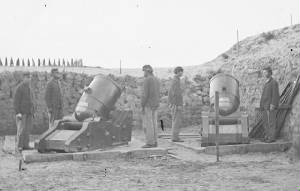
|
| Model 1841 10 in. seacoast mortars |
The earlier Model 8- and 10-inch mortars from the 1840s experienced
upgrades in 1861, which included longer bores (barrels) that enabled the larger versions to achieve greater distances. The
Model 10-inch Seacoast Mortar weighed approximately 7,300 pounds and, elevated at 45 degrees, was capable of delivering the
98-lb. explosive shell to its destination of 4,536 yards, or greater than 2.5 miles, which was nearly twice the
range of the Model 10-in. Siege Mortar. The 8-inch mortar was produced generally for siege operations, but the Model
10-inch was manufactured with two classifications: siege and garrison, and seacoast. Although Model 10-inch mortars
were designated for both siege and coastal operations, the seacoast model was the much larger and more powerful version. While
its screeching sound was ominous to soldiers and sailors alike, this mortar, enjoying its trajectory, was
proficient at pounding targets inside fortifications, obstructed targets, navy warships, trenches, and even the once
believed impenetrable "earthwork fort."
The Model 1861 13-inch Seacoast
Mortar was merely a larger version of the 10-inch seacoast model. In April 1862, the heavy 13-inch mortars were employed
on the Virginia Peninsula during the defenses of Yorktown. Subsequently, the behemoth 13-inch mortars played a prominent role
in the war effort along the coasts and in many siege operations. Their employment at locations from the Mississippi River
to the trenches of Petersburg ensured the 13-inch mortar a place among the most important weapons of the war.
(Right) Federal battery with Model 1841 10-inch seacoast mortars on Morris Island, during the
Campaign against Charleston Harbor.
Seacoast mortars constituted the heaviest category in mid-19th Century U.S. Artillery ordnance,
being considerably larger than siege mortars of this same caliber. The seacoast mortar class was designed to provide heavy,
long-range defensive fire around a major strategic position such as a harbor or city, thus eliminating the need for mobility.
The siege mortars were lighter versions specifically created for transport during offensive operations: to bombard a fortified
stronghold, for example. Mortars were often emplaced together in batteries, although it was recommended that the total concentration
not exceed three or four pieces, each weapon being assigned its own individual number so as to minimize any confusion during
battle. To battery fire simultaneous salvoes: every mortar in the battery had to first be properly loaded and aimed,
and only when all crews exhibited readiness, would the officer in command of the battery shout the general directive
to “Commence firing!”
Model 13-inch Seacoast Mortar
| Artillery Piece |
Overall Length (inches) |
Weight (pounds) |
Weight of Loaded Shell (lbs.) |
Powder Charge (pounds) |
Range (yards) |
Total Produced |
Manufacturers |
|
Model 1841 13-inch
Seacoast Mortar |
53 |
11,502 |
200 |
20 |
4,325 |
1 |
Alger |
|
Model 1861 13-inch
Seacoast Mortar |
56.5 |
17,120 |
227 |
20 |
4,325 |
162 |
Fort Pitt |
| The mortar high and low angle fire |
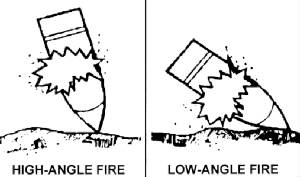
|
| High-angle and Low-trajectory fire |
Mortars were classed as "siege" or "seacoast" guns. The 8-inch and 10-inch
mortar siege guns, while cumbersome, could be transported on mortar wagons. The longer and heavier seacoast models of
the 10-inch and the giant 13-inch mortars were classified as "seacoast," as they could only be transported with great
difficulty by rail or ship. Mortars typically used spherical shells, and both timed and percussion fuses. Although experiments
were made using canister shot as shells, the gun crews were unable to remain at their guns under the shower of metal. While
five artillerists were needed to operate the 13-inch siege mortar, the sea or naval application required a crew of eleven
men: load, fire, rotate the bed to train to target.
The Model 1861 13-inch Seacoast Mortar received major upgrades from its
1840s predecessor, and, used by both the Union Army and Navy, it engaged in several theaters of the Civil War. Employed
by both naval and land based batteries, the 13-inch mortar engaged targets from the bombardment of Fort Pulaski, siege
of Vicksburg, operations against Charleston, to the nearly 10 month Richmond-Petersburg siege. With the replacement
of masonry fortifications with earthen works, mortars became vital. Works that could resist the horizontal fire of guns were
still vulnerable to the vertical fire of mortars. While five artillerists manned this mammoth weapon, the maximum range
of the 13-inch mortar was 4,325 yards, with its effective or accurate range being slightly less.
Weighing more than 17,000 pounds, this mortar, with a 20-lb.
powder charge and at 45 degrees elevation, enjoyed a maximum range of 4,325 yards, or approximately 2.5 miles, with a
227-lb. "loaded shell." The 1861 13-inch mortar was produced from 1860-1864 at the Fort Pitt Foundry, Pittsburgh PA., cast
of iron, and its projectiles were round mortar shells (cannon ball). Developed in an age of massive innovation in ordnance
technology, the 13-inch seacoast mortar became one of the most formidable weapons used during the Civil War.
The most famous of the 13-inch mortars, with its nom de guerre of "Dictator,"
was mounted on a railroad flatcar, from which it fired into the city of Petersburg, VA. Aiming was accomplished by merely
rolling the flatcar to various locations along a curved section of the track. The 13-inch seacoast mortar used by Union forces
most likely went to scrap by the end of the 1800's, as was the precedent.
Characteristics: Type: Model 1861 13-inch Siege and Seacoast Mortar
• Rarity: Uncommon • Years of Manufacture: Between 1860 and 1864 • Tube Composition: Iron • Bore Diameter:
13 inches • Standard Powder Charge: 20 lbs. • Projectiles: 200 lbs. Round Mortar Shells • Tube Length: 56.5
inches • Tube Weight: 17,250 lbs. • Range (at 45°): 4,325 yards • US Casting Foundry: Fort Pitt Foundry,
Pittsburgh PA.
| Battery of 13-inch Mortars in May 1862 |
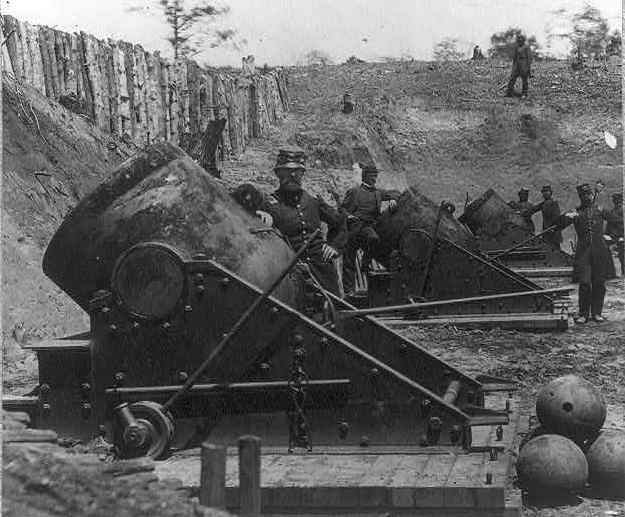
|
| Siege of Yorktown, VA. Federal Battery No. 4 Soldiers with three 13 inch mortars |
| Model 1861 13-inch Seacoast Mortar Battery |
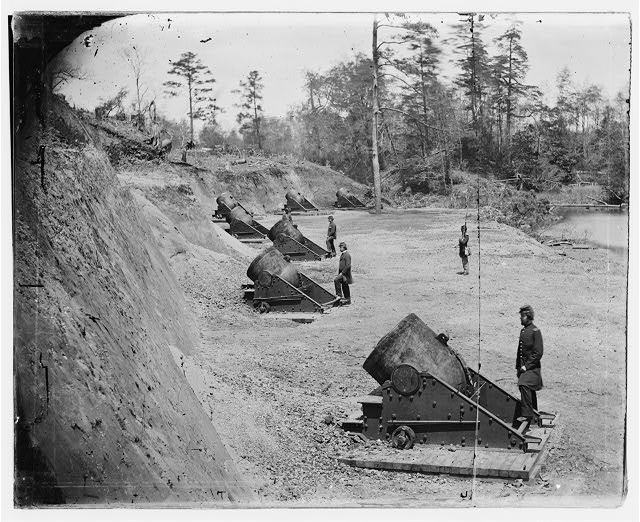
|
| Yorktown, Virginia. Battery No. 4 mounting 13-inch mortars at South end in May 1862 |
Model 1861 13-inch Seacoast Mortar
Class: Seacoast, heavy
Type: Mortar, smoothbore
Manufactured: 1860 to 1864
Tube Composition: Iron
Bore Diameter: 13 inches
Standard Powder Charge: 20 lbs.
Projectiles: 200 lbs. Round Mortar Shells
Tube Length: 56.5 inches
Tube Weight: 17,250 lbs.
Range (at 45°): 4,325 yards
US Casting Foundry: Fort Pitt Foundry, Pittsburgh PA
Notes: Destroyed well-entrenched targets that would
have otherwise remained intact by the employment of rifled guns, smoothbore artillery, and howitzers.
Principal Characteristics of Seacoast Artillery
| Seacoast Artillery |
Artillery
Piece |
Bore
diameter
(inches) |
Material |
Length
of tube
(inches) |
Weight
of tube
(pounds) |
Weight of
projectile
(pounds) |
Weight of
charge
(pounds) |
Range at 5°
elevation
(yards) |
| 32-pdr Gun |
6.40 |
Iron |
125.20 |
7,200 |
32.6 |
8.00 |
1,922 |
| 42-pdr Gun |
7.00 |
Iron |
129.00 |
8,465 |
42.7 |
10.50 |
1,955 |
| 8-inch Columbiad |
8.00 |
Iron |
124.00 |
9,210 |
65.0 |
10.00 |
5 1,813 |
| 10-inch Columbiad |
10.00 |
Iron |
126.00 |
15,400 |
128.0 |
18.00 |
6 1,814 |
| 15-inch Columbiad |
15.00 |
Iron |
182.00 |
50,000 |
1 302.0 |
40.00 |
7 1,518 |
| 100-pdr Parrott |
6.40 |
Iron |
151.00 |
9,700 |
100.0 |
10.00 |
8 2,247 |
| 200-pdr Parrott |
8.00 |
Iron |
159.00 |
16,300 |
175.0 |
16.00 |
2,000 |
| 300-pdr Parrott |
10.00 |
Iron |
173.00 |
26,500 |
250.0 |
25.00 |
--- |
| 10-inch Mortar |
10.00 |
Iron |
46.00 |
5,775 |
1 87.5 |
10.00 |
2 4,250 |
| 13-inch Mortar |
13.00 |
Iron |
53.00 |
17,120 |
1 220.0 |
20.00 |
2 4,325 |
| 80-pdr Whitworth Rifle |
5.00 |
Iron |
120.00 |
8,960 |
70.0 |
12.00 |
7,722 |
70-pdr Armstrong
Breechloading Rifle |
6.40 |
Iron &
Steel |
110.00 |
6,903 |
71.7 |
10.00 |
9 2,266 |
| 8-inch Blakely Rifle |
8.00 |
Steel |
3 156.00 |
17,000 |
200.0 |
50.00 |
--- |
| 150-pdr Armstrong Rifle |
8.50 |
Steel |
129.75 |
14,896 |
150.0 |
20.00 |
--- |
| 12 3/4-inch Blakely Rifle |
12.75 |
Steel |
192.00 |
54,000 |
1 700.0 |
--- |
--- |
1. Weight of shell.
2. Mortar ranges are given at an elevation
of 45°.
3. Bore length only.
4. Designed to be moved and operated by two men.
5. Obtained ranges greater than 4,812
yards with shell and 27° elevation.
6. Obtained ranges greater than 5,600 yards with shell and 39° elevation.
7. Obtained
ranges of 4,680 yards with a 315-lb. shell and 50 lbs. powder at 25°.
8. Extreme range of 8,428 yards.
9. Muzzle-loading
Armstrongs had practically identical dimensions and ranges.
| Civil War soldier gut shot by shell |
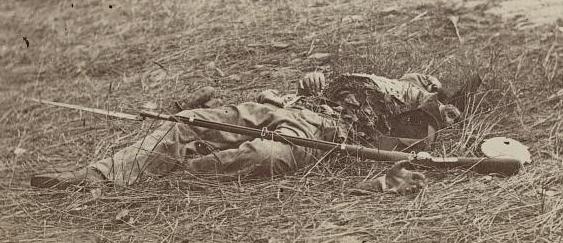
|
| Soldier disembowelled by a shell at Gettysburg |
At the opening of this civil conflict most of the matériel for both armies
was of the same type—smoothbore. The various guns included weapons in the great masonry fortifications built on the
long United States coast line since the 1820's—weapons such as the Columbiad, a heavy, long-chambered American muzzle-loader
of iron, developed from its bronze forerunner of 1810. The Columbiad was
made in 8-, 10-, and 12-inch calibers and could throw shot and shell well over 5,000 yards. "New" Columbiads exited the
foundries at the start of the 1860's, minus the powder chamber and with smoother lines. Behind the parapets or in fort gunrooms
were 32- and 42-pounder iron seacoast guns; 24-pounder bronze howitzers
lay in the bastions to flank the long reaches of the fort walls. There were 8-inch seacoast howitzers for heavier work. The
largest caliber piece was the ponderous 13-inch seacoast mortar.
Siege and garrison cannon included 24-pounder and 8-inch bronze howitzers, a 10-inch bronze mortar, 12-,
18-, and 24-pounder iron guns and later the 4-1/2-inch cast-iron rifle.
With the exception of the new 3-inch wrought-iron rifle, field artillery
cannon were bronze: 6- and 12-pounder guns, the 12-pounder Napoleon gun-howitzer, 12-pounder mountain howitzer, 12-, 24-,
and 32-pounder field howitzers, and the little Coehorn mortar. A machine
gun invented by Dr. Richard J. Gatling became part of the artillery equipment during the war, but was not much used. Reminiscent
of the ancient ribaudequin, a repeating cannon of several barrels, the Gatling gun could fire about 350 shots a minute from
its 10 barrels, which were rotated and fired by turning a crank. In Europe it became more popular than the French mitrailleuse.
The smaller smoothbores were effective with case shot up to about 600
or 700 yards, and maximum range of field pieces went from something less than the 1,566-yard solid-shot trajectory
of the Napoleon to about 2,600 yards (1.5 miles) for a 6-inch howitzer. At Chancellorsville, one of Stonewall Jackson's guns
fired a shot which bounded down the center of a roadway and came to rest a mile away. The performance verified the drill-book
tables. Maximum ranges of the larger pieces, however, ran all the way from the average 1,600 yards of an 18-pounder garrison
gun to the well over 3-mile range of a 12-inch Columbiad firing a 180-pound shell at high elevation. A 13-inch seacoast mortar
would lob a 200-pound shell 4,325 yards, or almost 2-1/2 miles. The shell from an 8-inch howitzer carried 2,280 yards, but
at such extreme ranges the guns could hardly be called accurate.
On the battlefield, Napoleon's artillery tactics were no longer practical.
The infantry, armed with its own comparatively long-range firearm, was usually able to keep artillery beyond case-shot range,
and cannon had to stand off at such long distances that their primitive ammunition was relatively ineffective. The result
was that when attacking infantry moved in, the defending infantry and artillery were still fresh and unshaken, ready to pour
a devastating point-blank fire into the assaulting lines. Thus, in spite of an intensive 2-hour bombardment by 138 Confederate
guns at the crisis of Gettysburg, as the gray-clad troops advanced across the field to close range, double canister and concentrated
infantry volleys cut them down in masses.
Field artillery smoothbores, under conditions prevailing during the war, generally
gave better results than the smaller-caliber rifle. A 3-inch rifle, for instance, had twice the range of a Napoleon; but in
the broken, heavily wooded country where so much of the fighting took place, the superior range of the rifle could not be
used to full advantage. Neither was its relatively small and sometimes defective projectile as damaging to personnel as case
or grape from a larger caliber smoothbore. At the first battle of Manassas (July 1861) more than half the 49 Federal cannon
were rifled; but by 1863, even though many more rifles were in service, the majority of the pieces in the field were still
the old reliable 6- and 12-pounder smoothbores.
It was in siege operations that the rifles forced a new era. As the smoke
cleared after the historic bombardment of Fort Sumter in 1861, military men were already speculating on the possibilities
of the new weapon. A Confederate 12-pounder Blakely had pecked away at Sumter with amazing accuracy. But the first really
effective use of the rifles in siege operations was at Fort Pulaski (1862). Using 10 rifles and 26 smoothbores, General Gillmore
breached the 7-1/2-foot-thick brick walls in little more than 24 hours. Yet his batteries were a mile away from the target!
The heavier rifles were converted smoothbores, firing 48-, 64-, and 84-pound James projectiles that drove into the fort wall
from 19 to 26 inches at each fair shot. The smoothbore Columbiads could penetrate only 13 inches, while from this range the
ponderous mortars could hardly hit the fort. A year later, Gillmore used 100-, 200-, and 300-pounder Parrott rifles against
Fort Sumter. The big guns, firing from positions some 2 miles away and far beyond the range of the fort guns, reduced Sumter
to a smoking mass of rubble.
| 15-inch Rodman gun |
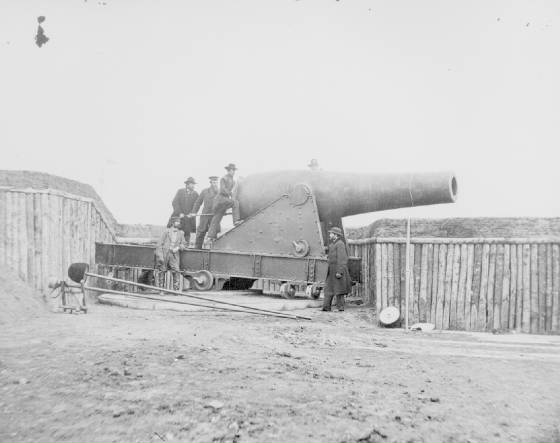
|
| A 15-inch Rodman gun in Battery Rodgers, Alexandria, VA. |
| Civil War heavy artillery |
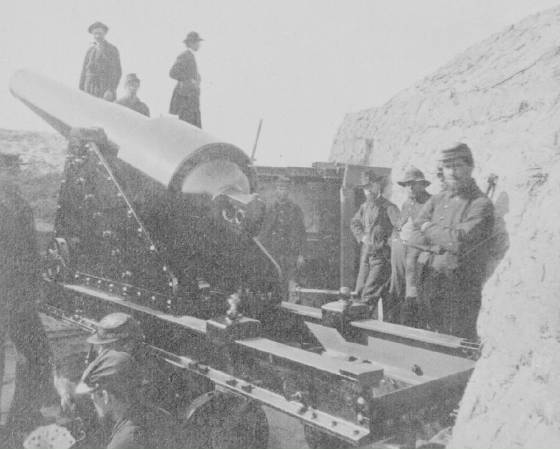
|
| A 200-pounder Parrott rifle in Fort Gregg on Morris Island, S.C., 1865 |
The range and accuracy
of the rifles startled the world. A 30-pounder (4.2-inch) Parrott had an amazing carry of 8,453 yards with 80-pound hollow
shot; the notorious "Swamp Angel" that fired on Charleston in 1863 was a 200-pounder Parrott mounted in the marsh 7,000 yards
from the city. But strangely enough, neither rifles nor smoothbores could destroy earthworks. As was proven several times
during the war, the defenders of a well-built earthwork were able to repair the trifling damage done by enemy fire almost
as soon as there was a lull in the shooting. Learning this lesson, the determined Confederate defenders of Fort Sumter in
1863-64 refused to surrender, but under the most difficult conditions converted their ruined masonry into an earthwork almost
impervious to further bombardment.
With Rodman's gun, the muzzle-loading smoothbore was at the apex of its development.
Through the years great progress had been made in mobility, organization, and tactics. Now a new era was beginning, wherein
artillery surpassed even the decisive role it had under Gustavus Adolphus and Napoleon. In spite of new infantry weapons that
forced cannon ever farther to the rear, artillery was to become so deadly that its fire caused over 75 percent of the battlefield
casualties in World War I.
Many of the vital changes took place during the latter years of the 1800's,
as rifles replaced the smoothbores. Steel came into universal use for gun founding; breech and recoil mechanisms were perfected;
smokeless powder and high explosives came into the picture. Hardly less important was the invention of more efficient sighting
and laying mechanisms.
The changes did not come overnight. In Britain, after breechloaders had been
in use almost a decade, the ordnance men went back to muzzle-loading rifles; faulty breech mechanisms caused too many accidents.
Not until one of H.M.S. Thunderer's guns was inadvertently double-loaded did the English return to an improved breechloader.
The steel breechloaders of the Prussians, firing two rounds a minute with
a percussion shell that broke into about 30 fragments, did much to defeat the French (1870-71). At Sedan, the greatest artillery
battle fought prior to 1914, the Prussians used 600 guns to smother the French army. So thoroughly did these guns do their
work that the Germans annihilated the enemy at the cost of only 5 percent casualties. It was a demonstration of using great
masses of guns, bringing them quickly into action to destroy the hostile artillery, then thoroughly "softening up" enemy resistance
in preparation for the infantry attack. While the technical progress of the Prussian artillery was considerable, it was offset
in large degree by the counter-development of field entrenchment.
As the technique of forging large masses of steel improved, most nations adopted
built-up (reinforcing hoops over a steel tube) or wire-wrapped steel construction for their cannon. With the advent of the
metal cartridge case and smokeless powder, rapid-fire guns came into use. The new powder, first used in the Russo-Turkish
War (1877-78), did away with the thick white curtain of smoke that plagued the gunner's aim, and thus opened the way for production
of mechanisms to absorb recoil and return the gun automatically to firing position. Now, gunners did not have to lay the piece
after every shot, and the rate of fire increased. Shields appeared on the gun—protection that would have been of little
value in the days when gunners had to stand clear of a back-moving carriage.
During the early 1880's the United States began work on a modern system of
seacoast armament. An 8-inch breech-loading rifle was built in 1883, and the disappearing carriage, giving more protection
to both gun and crew, was adopted in 1886. Only a few of the weapons were installed by 1898; but fortunately the overwhelming
naval superiority of the United States helped bring the War with Spain to a quick close.
During this war, United States forces were equipped with a number of British
2.95-inch mountain rifles, which, incidentally, served as late as World War II in the pack artillery of the Philippine Scouts.
Within the next few years the antiquated pieces such as the 3-inch wrought-iron rifle, the 4.2-inch Parrott siege gun, converted
Rodmans, and the 15-inch Rodman smoothbore were finally pushed out of the picture by new steel guns. There were small-caliber
rapid-fire guns of different types, a Hotchkiss 1.65-inch mountain rifle, and Hotchkiss and Gatling machine guns. The basic
pieces in field artillery were 3.2- and 3.6-inch guns and a 3.6-inch mortar. Siege artillery included a 5-inch gun, 7-inch
howitzers, and mortars. In seacoast batteries were 8-, 10-, 12-, 14-, and 16-inch guns and 12-inch mortars of the primary
armament; intermediate rapid-fire guns of 4-, 4.72-, 5-, and 6-inch calibers; and 6- and 15-pounder rapid-fire guns in the
secondary armament.
The Japanese showed the value of the French system of indirect laying (aiming
at a target not visible to the gunner) during the Russo-Japanese War (1904-05). Meanwhile, the French 75-mm. gun of 1897,
firing 6,000 yards, made all other field artillery cannon obsolete. In essence, artillery had assumed the modern form. The
next changes were wrought by startling advances in motor transport, signal communications, chemical warfare, tanks, aviation,
and mass production.
| What are the parts of a cannon? |
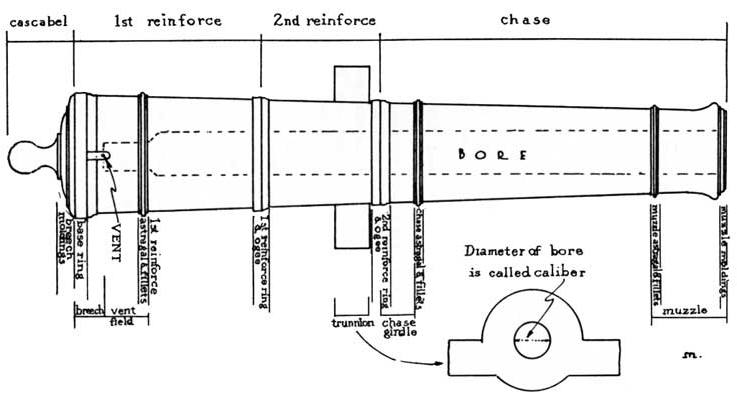
|
| Names of the parts of a cannon |
Most technical phrases are explained in the text, but for convenient reference,
however, some important words are defined below:
Abatis—means of defense surrounding a redoubt,
made of large tree branches facing the enemy, with the branches sharpened and the trunk partially buried in the ground. The
branches were sometimes interwoven to make removal difficult.
Artillery Train—see Siege Train.
Ballistics—the science dealing with the motion of projectiles.
Banquette—a step behind the parapet made high
enough so Soldiers standing on it could fire over the parapet. A slope or step was built for the Soldiers to reach the banquette.
Barbette carriage—as used here, a traverse carriage on
which a gun is mounted to fire over a parapet.
Berm—level earth between the parapet and the
ditch, to keep the parapet from sliding into the ditch.
Breastwork—hastily constructed parapet, usually made of earth and wood,
designed to protect the defenders against artillery and musketry fire. Also known as an entrenchment or field trench.
Breechblock—movable piece which closes the breech
of a cannon.
Caliber—diameter of the bore; also used to express bore
length. A 30-caliber gun has a bore length 30 times the diameter of the bore.
Cartridge—bag or case holding a complete powder charge
for the cannon, and in some instances also containing the projectile.
Casemate carriage—traverse carriage in a fort gunroom (casemate).
The gun fired through an embrasure or loophole in the wall of the room.
Chamber—the part of the bore which holds the propelling
charge, especially when of different diameter than the rest of the bore; in chambered muzzle-loaders, the chamber diameter
was smaller than that of the bore.
Cheveaux de Frize—pieces of wood ten to twelve
feet long with thin, wooden, pointed pins along the length of all four sides.
Counter-battery—number of guns placed behind a parapet with the primary
purpose of dismounting or silencing the guns in an enemy’s work by using direct fire.
Ditch—six to seven and a half foot crevasse immediately
before the parapet.
Earthwork—see Fortification.
Elevation—the angle between the axis of a piece and the
horizontal plane.
Embrasures—openings in the parapet for cannons
to fire through.
Entrance—positioned in the rear of the redoubt,
and built wide enough for the artillery.
Epaulement—elevation constructed in order to protect troops and batteries
from the fire of the enemy. It was usually composed of gabions filled with earth, or sand bags.
Fascines—bundles of tree branches tied with yarn,
from six to eighteen feet long and a foot or wider in girth. Used as a support structure in parapet
construction. Assaulting troops used fascines to fill in the ditch and create a bridge to the parapet.
Fortification—term for field works, forts, and fortresses.
Most fortifications had at least a rampart and parapet.Natural fortifications consisted of objects formed by nature, which
were capable of impeding the advance of an enemy.
Fraises—logs, with pointed ends, placed at an
angle near the base of the parapet and extended out over the berm and ditch.
Fuze—device to ignite
the charge of a shell or other projectile. Fuzes for projectiles may be classified as time-fuzes, percussion-fuzes, and combination-fuzes.
The time-fuze serves to explode a projectile during flight, or at the end of a given period of time after its discharge from
the gun. The percussion-fuze, rifled guns, serves to explode a projectile either during flight or on impact.
Gabions—basket-shaped devises made from intertwined
branches and twigs, standing two or three feet high and several feet around.
Glacis—slightly rising slope of earth just before
the ditch.
Grommet—rope ring used as a wad to hold a cannonball in
place in the bore.
Gun—any firearm; in the limited sense, a long cannon with
high muzzle velocity and flat trajectory.
Gun Platform—wooden platforms upon which cannon
sit.
Gun Ramp—also known as apareilles, earth and
wood ramp built to allow large cannons to be moved into and out of positions.
Howitzer—short cannon, intermediate between the gun and
mortar.
Lanyard—made of a strong twisted cord, usually 8 to
12-feet long, with a wooden handle attached at one end and an iron hook at the other. The lanyard hook was attached to the
eye in the serrated wire of the friction primer after the primer was seated into the vent. The gunner would grip the wooden
handle and pull the lanyard quickly, thereby causing the wire to pull through the primer, causing a spark. This would ignite
the powder charge in the tube.
Lay—to aim a gun.
Limber—two-wheeled vehicle to which the gun trail is attached
for transport.
Mandrel—metal bar,
used as a core around which metal may be forged or otherwise shaped.
Matrix—medium of sulphur, asphaltum-pitch, or tree
rosin added to the interior of a case-shot projectile for the purpose of stabilizing the case-shot balls. The matrix helped
prevent damage to the bursting charge can or cavity and prevented accidental discharge caused by movement of the cast-shot
balls during the firing process.
Merlon—the
wall of the parapet between embrasures.
Mortar—very short cannon used for high or curved trajectory
firing.
Ordinance Department—department of the Army charged
with procuring ordnance and ordnance stores. Since this department often employed contractors and contract labor, it
carried a number of trained army officers as Inspectors of Ordnance, whose primary function was to certify the quality of
the ordnance purchased.
Palisades—pointed vertical logs driven into the
bottom of the ditch.
Parapet—the mound of earth which formed the perimeter
of a redoubt. It was the primary protection for Soldiers within the redoubt.
Point-blank—the point where the projectile, when fired
from a level bore, first strikes the horizontal ground in front of the cannon.
Projectiles—canister or case shot: a can filled
with small missiles that scatter after firing from the gun. Grape shot: a cluster of small iron balls, which scatter
upon firing. Shell: explosive missile; a hollow cast-iron ball, filled with gunpowder, with a fuze to produce detonation;
a long, hollow projectile, filled with explosive and fitted with a fuze. Shot: a solid projectile, non-explosive.
Quoin—wedge placed under the breech of a gun to fix its
elevation.
Rampart—steeply sloped earthen embankment topped by a parapet.
Range—the horizontal distance from a gun to its
target or to the point where the projectile first strikes the ground. Effective range is the distance at which effective
results may be expected, and is usually not the same as maximum range, which means the extreme limit of range.
Recoil—backward movement of a cannon immediately after being discharged.
It was necessary to reposition the weapon after each recoil.
Redan—form of angled breastworks shaped like a V with its point facing the
approach of the enemy.
Redoubt—small separate defensive work consisting
of blockhouse or earthen works. Detached outworks as part of a larger defensive
plan, usually square without defensive flanks. Could also be polygonal or hexegonal shapes.
Ricochet—firing a solid shot
at such a low angle of elevation which caused the shot to graze (strike) a hard surface, bounce up, and travel close to the
surface. Ricochet fire was used to destroy gun carriages, inflict greater damage on enemy troops, and, in the navy, to increase
the chances of striking an enemy ship at the water line.
Rifle Pit—small trench for one or two men with
a slight parapet or other cover in front. Rifle pits were generally established well in advance of a fortification's outworks
or main line of field works in front or on the flanks of a besieging army's approaches. Fire from rifle pits was used to harass
the enemy.
Rotating band—band of soft metal, such as copper, which
encircles the projectile near its base. By engaging the lands of the spiral rifling in the bore, the band causes rotation
of the projectile. Rotating bands for muzzle-loading cannon were expansion rings, and the powder blast expanded the ring into
the rifling grooves.
Sacs a Terre—burlap or cloth sacks filled with
earth much like today's sandbags, used to build parapets and other defenses.
Salvo—simultaneous discharge of artillery against a target.
Salient—part of a fortification defensive line
called a cremaillere or indented line. The salient was an angle, or sharp point, which faced out towards the enemy and was
constructed as the simplest of entrenchments.
Scarp—the side of the ditch leading up to the
parapet.
Siege Train—military organization consisting of varying numbers of artillery
weapons proportioned according to caliber and type. Siege weapons (guns, howitzers, mortars) were usually organized in trains
of 100 pieces along with the required carriages, horses, ammunition, and gunpowder. Field trains were considerably smaller,
usually consisting of three field weapons (guns and howitzers) per 1,000 infantry.
Sods—earth bricks with grass on one side, placed
on the parapet to prevent erosion.
Stockade—timber wall or defensive barrier, i.e.,
palisade.
Train—to aim a gun.
Trajectory—curved path taken by a projectile in its flight
through the air.
Transom—horizontal beam between the cheeks of a gun carriage.
Traverse—parts of parapets, which crossed the
breadth of the covered way, at the salient and re-entering places of arms.
Traverse carriage—stationary gun mount, consisting of a
gun carriage on a wheeled platform which can be moved about a pivot for aiming the gun to right or left.
Trous-de-loup—pits shaped like an upside-down
cone, six feet around the top and six feet deep, sometimes with a pointed stake in the center. These
pits were usually placed in front of the ditch to trap advancing infantry and cavalry.
Trunnions—2 cylindrical pivots cast on the exterior
of a cannon or mortar at its center of gravity. They rest on the field carriage or platform carriage and allow the weapon
to be elevated or depressed easily.
Variant—minor differences found within a projectile pattern or sub-pattern,
such as a wooden drive-in paper time fuze adapter as opposed to a threaded paper time fuze adapter. These differences are
not enough to reclassify the projectile, so the specimen is said to be a "variant" of that pattern.
Windage—difference
between the diameter of the shot and the diameter of the bore.
Sources: Library of Congress, National Archives, National Park Service,
US Army and Marine Training Manuals; US Army Ordnance Manual; The Ordnance Manual for the Use of the Officers of the United
States Army: United States Army Ordnance Department. J.B. Lippincott & Company, 1862; Gettysburg National Military Park; Vicksburg
National Military Park; Stones River National Battlefield; Shiloh National Military Park; Chickamauga and Chattanooga
National Military Park; Fredericksburg and Spotsylvania National Military Park; Antietam National Battlefield; Manassas
National Battlefield Park; Fort Sumter National Monument; Official Records of the Union and Confederate Navies in the
War of the Rebellion. United States Naval War Records Office Naval War Records Office, United States. Office of Naval Records
and Library. Publisher U.S. Government Printing Office, 1896; Official Records of the Union and Confederate Armies; Abbot,
Henry L. (1867). Siege artillery in the Campaigns Against Richmond, with Notes on the 15-inch Gun, Including an Algebraic
Analysis of the Trajectory of a Shot in its Ricochets Upon Smooth Water. Professional Papers of the Corps of Engineers United
States Army 14. Washington D.C.: Government Printing Office; Alexander, Edward Porter (1883). "Confederate Artillery Service".
Southern Historical Society Papers (Southern Historical Society) XI: 98–113; Gibbon, John (1863). The Artillerist's
Manual (2nd ed.). New York: D. Van Nostrand; Gilmore, Q.A. (1882). "Report from Hilton Head, S.C., October 20, 1865.". The
War of the Rebellion: A Compilation of the Official Records of the Union and Confederate Armies, Series I. (Washington, D.C.:
Government Printing Office) VI: 148–65; Gilmore, Q.A. (1890). "Report of Maj. Gen. Quincy A. Gilmore, U.S. Army, Commanding
Department of the South with Congratulatory Orders.". The War of the Rebellion: A Compilation of the Official Records of the
Union and Confederate Armies, Series I. (Washington, D.C.: Government Printing Office). XXVIII (Part I); Hickenlooper, Andrew
(1888). "The Vicksburg Mine.". Battles and Leaders of the Civil War (Thomas Yoseloff, 1956 Edition). (New York: Century Co.)
III: 539–542; Hunt, Henry J. (1894). "Report of Bvt. Maj. Gen. Henry J. Hunt, U.S. Army, June 1, 1865.". The War
of the Rebellion: A Compilation of the Official Records of the Union and Confederate Armies, Series I. (Washington, D.C.:
Government Printing Office) XLVI (Part I): 659–662; Mancucy, Albert (1955). Artillery Through the Ages: A Short Illustrated
History of Cannon, Emphasizing Types Used in America. Washington, D.C.: Government Printing Office; Parrott, Robert P. (1863).
Ranges of Parrott Guns and Notes for Practice. New York: D. Van Nostrand; Ripley, Warren (1984). Artillery and Ammunition
of the Civil War. Charleston, S.C.: The Battery Press; Turner, John W. (1890). "Reports.". The War of the Rebellion: A Compilation
of the Official Records of the Union and Confederate Armies, Series I. (Washington, D.C.: Government Printing Office). XXVIII
(Part I): 212–225; Wise, Stephen R. (1994). Gate of Hell: Campaign for Charleston Harbor, 1863. Columbia, S.C.: University
of South Carolina Press; Alberts, Don E. The Battle of Glorieta: Union Victory in the West. College Station, Texas: Texas
A&M University Press, 2000; Benton, James G. Ordnance and Gunnery. Gettysburg, PA: Reprint, Thomas Publications (original
1862.); Cole, Philip M. Civil War Artillery at Gettysburg. New York: Da Capo Press, 2002. ISBN 0-306-81145-6; Daniel, Larry
J. and Gunter, Riley W. Confederate Cannon Foundries. Union City, Tennessee: Pioneer Press, 1977; Eicher, David J. The Longest
Night: A Military History of the Civil War. New York: Simon & Schuster, 2001. ISBN 0-684-84944-5; Grizzell, Stephen, "Bull
Pup: The 1841 Mountain Howitzer."; Hazlett, James C., Edwin Olmstead, and M. Hume Parks. Field Artillery Weapons of the American
Civil War, rev. ed., Urbana: University of Illinois Press, 1983. ISBN 0-252-07210-3; Nosworthy, Brent. The Bloody Crucible
of Courage, Fighting Methods and Combat Experience of the Civil War. New York: Carroll and Graf Publishers, 2003. ISBN 0-7867-1147-7;
Pfanz, Harry W. Gettysburg: Culp's Hill and Cemetery Hill. Chapel Hill: University of North Carolina Press, 1993. ISBN 0-8078-2118-7;
Ripley, Warren. Artillery and Ammunition of the Civil War. 4th ed. Charleston, SC: The Battery Press, 1984. OCLC 12668104;
Thomas, Dean S. Cannons: An Introduction to Civil War Artillery. Gettysburg, PA: Thomas Publications, 1985. ISBN 0-939631-03-2;
Gottfried, Bradley M. The Artillery of Gettysburg. Nashville, TN: Cumberland House Publishing, 2008. ISBN 978-1-58182-623-4;
Wise, Jennings C. The Long Arm of Lee: The History of the Artillery of the Army of Northern Virginia. New York: Oxford University
Press, 1959. OCLC 1150741; National Museum of Health and Medicine; Minnesota Historical Society; Manucy, Albert. National
Park Service, Artillery through the Ages: A Short Illustrated History of Cannon, Emphasizing Types Used in America (1956).
U.S. Government Printing Office Washington, D.C.; Price, William H. The Civil War Centennial Handbook (1961). Prince Lithograph
Co., Inc. Arlington, Virginia; Hess, Earl J. and Brendan Wolfe. "Pickett's Charge." Encyclopedia Virginia. Virginia Foundation
for the Humanities, 4 Dec. 2012.; Kinard, Jeff. Artillery: An Illustrated History of Its Impact, 2007; Gettysburg National Military Park. Gettysburg, Historical Handbook Number Nine (1954) (Revised
1962); National Park Service. Artillery Through The Ages: A Short Illustrated History of Cannon, Emphasizing Types Used in
America, Interpretive Series History No. 3 (1955); The Photographic History of The Civil War in Ten Volumes: Volume Five,
Forts and Artillery. The Review of Reviews Co., New York. 1911; Coggins, Jack. Arms and Equipment of the Civil War, Double
Day & Company, New York, 1962; Boatner, Mark M III. The Civil War Dictionary, David McKay Company, Inc, New York 1959;
Symonds, Craig L. The Civil War at Sea. Oxford University Press, USA; Reprint edition (October 5, 2012); Tactics, Techniques,
and Procedures for Field Artillery Manual Cannon Gunnery, Headquarters Department of the Army, U.S. Marine Corps, Washington,
D.C., 23 April 1996; Fox, William F. Regimental Losses in the American
Civil War (1889). Unless otherwise stated, all photographs, pictures, and artwork are courtesy public domain.
Return to American Civil War Homepage

|

|

|

